If anything confirmed that we need the two most recent Sherlock Holmes movies -- both the first Robert Downey, Jr. one and the recently-opened "A Game of Shadows" -- it's the party I went to where a teenaged girl was watching the first RDJ Holmes on DVD, and confessed that she had no idea who or what Sherlock Holmes was. This was stunning to me, because long before I read any of the Holmes stories, or saw any of the movies, or watched the excellent Jeremy Brett movies, I at least knew who Holmes and Watson were. I had at least seen the deerstalker hat, the meerschaum pipe, the magnifying glass, and identified them as being symbols of a detective named Sherlock Holmes. He is one of the most universally known fictional characters, up there with Tarzan, Superman, and Mickey Mouse. We may take that for granted, however. Holmes might eventually fade from the popular consciousness. To guard against that, we need new Sherlock Holmes movies.
And the latest one is a terrifically entertaining contribution to the collection of Holmes adaptations. Watching the first one, I learned that I could accept RDJ's and director Guy Ritchie's version of Holmes -- which focuses on the man-of-action martial artist Holmes who appears in some of the stories, rather than the cerebral drawing-room ratiocinator -- because it is not so foreign to the literary Holmes as to lose the spirit of the character. And I enjoyed the look of the films, which lend a subtle touch of the fabulous to the usual dreary Victorian England settings; not to mention Jude Law's Watson, who seems to have picked up an unusual number of fighting skills in the military for one who served as a military surgeon. (Why, in this film we learn that he can skillfully aim and fire artillary.)
"A Game of Shadows" expands upon the tapestry laid out in the first film, by moving to the territory which Holmes pastiches have often explored -- the chess game, played out on a global scale, between Holmes and his Player on the Other Side, Professor Moriarty, drawn in the broadest strokes in the story "The Final Problem." Moriarity is, of course, the model for the comic book supervillain, the James Bond baddie, and every other "big bad" who at least matches the hero for wits, and eclipses him or her in resources. So many of the Holmes stories paint him as an intellectual giant in a world of pygmies; so the concept of Holmes meeting a villain whose powers of logic and manipulation were equal or superior to his has fired the imaginations of readers.
The movie handles this aspect of the story well. We don't get the chilling scene from "The Final Problem" in which Moriarity suddenly appears in Holmes's study without Holmes seeing him enter (the scene here is played out in Moriarty's office at his university, which Holmes visits at the professor's invitation); but Jared Harris plays Moriarty as one who is firmly in control not only of what is happening in his immediate presence, but everything everywhere.
Not that the movie is a cerebral match of wits between the detective and the criminal. No, it's a big, loud, action-filled chase across Europe, complete with anarchist bombings, hand grenades, machine guns, trains, and automobiles. (No planes yet. Leave that for the next movie.) After all, you can't teach the young folks who Holmes is by boring them. They'll come for the action; hopefully, they'll come back (to the books) for the raciocination.
The scattershot musings of a Los Angeles appellate attorney and devotee of popular culture
Sunday, December 18, 2011
Sunday, December 04, 2011
A Tale of Two Conventions

We attended two conventions in November, and they were polar opposites of each other.
The first was Anime Vegas 2011, held November 11-13 in Las Vegas, Nevada. I had attended two other Anime Vegas conventions, and this one was the best run by far. The con was filled with young people, many in costumes; the masquerade was robust and full of entries; and the event vibrated with youth and enthusiasm. In particular, this Anime Vegas was energized by the revival of the license for the Hellsing Ultimate anime, which has been moribund in the U.S. for the last three years. The entire principal English dub cast for Hellsing Ultimate gathered in Las Vegas to promote the soon-to-be-released balance of the Hellsing Ultimate videos. We attended as fans, as enthusiastic as anyone else there.
The second convention was Loscon 38, held over Thanksgiving Weekend. This was a science fiction convention, rather than an anime con (although, in a convention tradition, anime was shown in a video room throughout the con). As is now the tradition with SF conventions, the attendees tended to be older than those who go to Anime Vegas and other anime cons; indeed, many attendees had been going to conventions for 40-50 years or more. The masquerade, alas, was anemic -- only nine entries, little in the way of MC-ing, and judges who were not even introduced until the awards were announced.
We attended this con as dealers (Amy's embroidery business, Heart of the Star, had a table in the dealer's room). That is a fun way to attend a convention, and we had a good time talking to folks from behind the table and selling Amy's wares (which were quite popular with the crowd). But keeping the table running meant that we had to carefully parse the con activities we attended during the show. I attended one panel during the con, as did Amy. (That one panel was a fantastic one, however -- a talk given by Nicholas Meyer, author of The Seven-Percent Solution and director of Time after Time, The Day After, and two of the best Star Trek films. And although there were folks in costume, far fewer costumes filled the halls than those on view at Anime Vegas.
As much as we enjoyed Loscon, however, we wondered how the energy, youth, and enthusiasm of an anime con such as Anime Vegas could be brought to an SF con such as Loscon. After all, many anime fans enjoy the same literary and cinematic SF and fantasy as Loscon attendees. Yet SF conventions such as Loscon don't register on the radar of anime fans. We hope that more young fans find Loscon and conventions of its ilk to their taste; otherwise, SF conventions may be in danger of eventually disappearing.
Lest I end this post on a negative note, I will point out one of the coolest aspects of this year's Anime Vegas. Amy, who is a big Hellsing fan, painted a cardboard coffin a few years ago to match the one shown in the Hellsing manga and anime. She took the opportunity of this reunion of Hellsing cast members to get the coffin autographed by the cast members; and I captured the autographing on video. Here are the video highlights.
Here, voice actress Victoria Harwood (who plays Integra in Hellsing) and ADR director/adaptor Taliesin Jaffe sign the coffin.
Ralph Lister, who plays Walter, signs the coffin:
As does Patrick Seitz, the voice of Luke Valentine and one of the scripters for the English dub of Hellsing Ultimate:
K.T. Gray, who voices Seras in the English Dub, signs the sinister sepulchre:
And finally, Crispin Freeman, the English voice of Alucard in Hellsing, signs on.
We folded the fully executed coffin flat, and transported it to its final resting place.
Movie Magic
I've been watching movies for quite a while; and once you've been doing that for a few decades, experiencing pure magic at the cinema becomes rare. Oh, you can be entertained, and you can marvel at spectacles such as Avatar, and you can be briefly transported by a moment here and there in a film. But getting sucked into a movie from beginning to end, to simply give up critical thinking and allow the filmmaker to lead you wherever he or she wants to go? That experience, so common when one watches movies as a child, becomes fleetingly rare as the decades mount.
Which is why I found Martin Scorsese's new film HUGO so amazing. From the first shot -- an incredible tracking shot across a crowded 1930s Paris train station, as the camera zooms by scores of people, each of whom is a story in himself or herself, into the eyes of the title character -- to the emotional ending -- I was helpless. Scorsese had me in the palm of his hand.
HUGO is, at heart, a children's film. It is devoid of cussing, of sex or graphic violence; it is told from the point of view of a child; and most of the scenes are shot from a child's-eye level. Perhaps the candy-bright child's-film look is one of the reasons the movie slipped past my intellectual defenses. Yet like the best children's film and literature, the movie is profound, filled with dialogue that touches upon universal truths and images that frighten and thrill.
What is HUGO about? It's historical fiction, although I won't reveal the particular history upon which it draws (and it's a shame that plot point has been revealed in the publicity surrounding the film). It's not science fiction, fantasy, or steampunk, despite its fascination with clockwork, gears, and locomotive steam. What it is about is family, and the relationship between people and machines, and the history of movies as a mechanical means of capturing dreams and making them visible to others -- all subjects that should resonate with Scorsese, the legendary champion of moviemaking. It's about healing, and coming to terms with loss and failure.
Most of all, it's about storytelling, verbal and visual. The movie tells a story about characters enthralled with stories, characters who find a huge story closer than they could imagine.
HUGO is shot in 3D, and that's how it should be enjoyed. It highlights the difference between the standard popcorn movie that is shot in 2D and converted to 3D (because that's what's hot nowadays), and a movie that is made in 3D, by a filmmake who uses the device as a storytelling tool. It's the difference between a colorized black and white movie and a film in which color is used to convey emotions and plot points. The 3D in HUGO is part of the film's magic, and shows that the process may not be a passing fad after all.
Movie fans of all ages should be glad films like HUGO are still coming out -- films that are toy boxes full of delights, but also toy boxes intricately carved and full of depth.
Which is why I found Martin Scorsese's new film HUGO so amazing. From the first shot -- an incredible tracking shot across a crowded 1930s Paris train station, as the camera zooms by scores of people, each of whom is a story in himself or herself, into the eyes of the title character -- to the emotional ending -- I was helpless. Scorsese had me in the palm of his hand.
HUGO is, at heart, a children's film. It is devoid of cussing, of sex or graphic violence; it is told from the point of view of a child; and most of the scenes are shot from a child's-eye level. Perhaps the candy-bright child's-film look is one of the reasons the movie slipped past my intellectual defenses. Yet like the best children's film and literature, the movie is profound, filled with dialogue that touches upon universal truths and images that frighten and thrill.
What is HUGO about? It's historical fiction, although I won't reveal the particular history upon which it draws (and it's a shame that plot point has been revealed in the publicity surrounding the film). It's not science fiction, fantasy, or steampunk, despite its fascination with clockwork, gears, and locomotive steam. What it is about is family, and the relationship between people and machines, and the history of movies as a mechanical means of capturing dreams and making them visible to others -- all subjects that should resonate with Scorsese, the legendary champion of moviemaking. It's about healing, and coming to terms with loss and failure.
Most of all, it's about storytelling, verbal and visual. The movie tells a story about characters enthralled with stories, characters who find a huge story closer than they could imagine.
HUGO is shot in 3D, and that's how it should be enjoyed. It highlights the difference between the standard popcorn movie that is shot in 2D and converted to 3D (because that's what's hot nowadays), and a movie that is made in 3D, by a filmmake who uses the device as a storytelling tool. It's the difference between a colorized black and white movie and a film in which color is used to convey emotions and plot points. The 3D in HUGO is part of the film's magic, and shows that the process may not be a passing fad after all.
Movie fans of all ages should be glad films like HUGO are still coming out -- films that are toy boxes full of delights, but also toy boxes intricately carved and full of depth.
Sunday, November 06, 2011
Disneyland in November
On November 5, 2011, we visited Disneyland for Amy's birthday. It was our second trip to Disneyland this year -- surprising for us, since our last trip to the Magic Kingdom before this year was on New Year's Eve 1999.

We caught a weather break for this trip: Although both Friday and Sunday were rainy, Saturday was clear and sunny -- albeit chilly for So Cal (weather in the 50s and 60s.) Further, we manage to avoid any serious mishaps or calamities during the trip (although my knee started hurting after a few hours of walking around and standing in line).

Disneyland in early November is a park in transition. Hallowe'en has just ended (although the Haunted Mansion is still done up in a Nightmare Before Christmas theme which I found a lot of fun), but the park is not done up in full holiday (read: Christmas -- Thanksgiving hardly exists in Disneyland) until November 14. Nevertheless, when we arrived, a Christmas parade was wending its way down Main Street U.S.A., taped for broadcast on Christmas Day. Even more time-warping: That evening, a segment of Dick Clark's Rockin' New Year (to be broadcast on Disney-owned ABC) was taped, to be shown you-known-when.

Disneyland is much like Las Vegas. If one approaches it with the right mindset -- an understanding that everything is a facade of imagery and misdirection -- it's a lot of fun. And surprises can still be found: In the Pavillion of Progress (or whatever they're calling it these days), in the midst of a Home of Tomorrow display that already looks like the Home of Last Week, we found a display with Honda's Asimo robot that just astounded us. Here are some videos I shot of this robot's amazing ambulation:
Three more observations I made while enjoying Disneyland:
First, I was surprised that Disney devotes so little energy to promoting its current productions. One would expect some kind of display or attraction in Tomorrowland for Disney's current hit SF movie REAL STEEL, or some kind of ride or sign in Fantasyland for ONCE UPON A TIME, its ABC tv series. You would at least expect one of the omnipresent gift shops to feature merch from these works. But no. Same for recent movies such as ENCHANTED.
Second, the gift shops could use a bit more variety. I know that the Disney Pins have become a hobby in themselves, but nearly every shop seemed to carry the same pins (which could also be had in the Disney World store outside the park's gates). Keying the shops to the locations to a greater degree would seem to make more sense.
Finally, I would expect to find theaters showing Disney cartoons at Disneyland. You will see images galore of Mickey Mouse, Donald Duck, and the crew; but none of the cartoons in which the characters appeared. The only place to see any semblance of such animation is the Main Street Cinema, which shows altered video versions of Mickey Mouse cartoons. (For instance, MM shorts that are color and have sound are shown in black and white without sound.) This is a shame, because despite Disney's TV empire and the multiple channels it owns, Disney's animated shorts seem to seldom be broadcast. Likely many kids who grow up loving the images of Mickey and Donald have never seen any of the classic cartoons in which they appeared. I suspect this is part of Disney's design: Reducing classic cartoon characters to mere images, without personality or character, optimized for merchandising and commerce.
Oh, and I really enjoyed Disneyland. So did Amy.


We caught a weather break for this trip: Although both Friday and Sunday were rainy, Saturday was clear and sunny -- albeit chilly for So Cal (weather in the 50s and 60s.) Further, we manage to avoid any serious mishaps or calamities during the trip (although my knee started hurting after a few hours of walking around and standing in line).

Disneyland in early November is a park in transition. Hallowe'en has just ended (although the Haunted Mansion is still done up in a Nightmare Before Christmas theme which I found a lot of fun), but the park is not done up in full holiday (read: Christmas -- Thanksgiving hardly exists in Disneyland) until November 14. Nevertheless, when we arrived, a Christmas parade was wending its way down Main Street U.S.A., taped for broadcast on Christmas Day. Even more time-warping: That evening, a segment of Dick Clark's Rockin' New Year (to be broadcast on Disney-owned ABC) was taped, to be shown you-known-when.

Disneyland is much like Las Vegas. If one approaches it with the right mindset -- an understanding that everything is a facade of imagery and misdirection -- it's a lot of fun. And surprises can still be found: In the Pavillion of Progress (or whatever they're calling it these days), in the midst of a Home of Tomorrow display that already looks like the Home of Last Week, we found a display with Honda's Asimo robot that just astounded us. Here are some videos I shot of this robot's amazing ambulation:
Three more observations I made while enjoying Disneyland:
First, I was surprised that Disney devotes so little energy to promoting its current productions. One would expect some kind of display or attraction in Tomorrowland for Disney's current hit SF movie REAL STEEL, or some kind of ride or sign in Fantasyland for ONCE UPON A TIME, its ABC tv series. You would at least expect one of the omnipresent gift shops to feature merch from these works. But no. Same for recent movies such as ENCHANTED.
Second, the gift shops could use a bit more variety. I know that the Disney Pins have become a hobby in themselves, but nearly every shop seemed to carry the same pins (which could also be had in the Disney World store outside the park's gates). Keying the shops to the locations to a greater degree would seem to make more sense.
Finally, I would expect to find theaters showing Disney cartoons at Disneyland. You will see images galore of Mickey Mouse, Donald Duck, and the crew; but none of the cartoons in which the characters appeared. The only place to see any semblance of such animation is the Main Street Cinema, which shows altered video versions of Mickey Mouse cartoons. (For instance, MM shorts that are color and have sound are shown in black and white without sound.) This is a shame, because despite Disney's TV empire and the multiple channels it owns, Disney's animated shorts seem to seldom be broadcast. Likely many kids who grow up loving the images of Mickey and Donald have never seen any of the classic cartoons in which they appeared. I suspect this is part of Disney's design: Reducing classic cartoon characters to mere images, without personality or character, optimized for merchandising and commerce.
Oh, and I really enjoyed Disneyland. So did Amy.

Sunday, October 23, 2011
Jump to Digital
The remarkable leaps Japanese comics (manga) and animation (anime) made in popularity in the U.S. in the past decade is, depending on how you look at it, either waning or entering a new phase. Already several of the anime and manga U.S. licensors that dominated the market in the last few years have slid off the board. Now Viz, the licensor that has plugged away for longer than any other company (it started putting manga onto the U.S. market in the mid-eighties, with licensed anime following a few years after) has announced that next year its periodical publication, the U.S. edition of Shonen Jump, will cease print publication. It will continue life as a digital magazine.
This is a particularly surprising development considering that Viz has arguably the most popular licensed properties in the U.S. and Japan. Bleach and Naruto have been tremendously popular on both sides of the Pacific. And Viz has other titles that have followings, such as One Piece, Tiger & Bunny, Deathnote, Rosario Vampire, Blue Exorcist, etc.
For such a juggernaut to opt to discontinue its flagship publication showcases not only the burst of the manga/anime bubble, but the general decline of the magazine market in America.
The American Shonen Jump is not dead (for now), but the end of its life as a paper publication is likely a harbinger for larger changes in the print world as a whole.
This is a particularly surprising development considering that Viz has arguably the most popular licensed properties in the U.S. and Japan. Bleach and Naruto have been tremendously popular on both sides of the Pacific. And Viz has other titles that have followings, such as One Piece, Tiger & Bunny, Deathnote, Rosario Vampire, Blue Exorcist, etc.
For such a juggernaut to opt to discontinue its flagship publication showcases not only the burst of the manga/anime bubble, but the general decline of the magazine market in America.
The American Shonen Jump is not dead (for now), but the end of its life as a paper publication is likely a harbinger for larger changes in the print world as a whole.
Sunday, October 16, 2011
E-Book Follies
Unless we are in the throws of a fad, book retailing is gradually, but perhaps inexorably, moving away from physical books and toward e-books. I doubt paper books will ever stop being sold; but they may eventually become like vinyl records, still sold for major albums but found only in high-end shops and second-hand shops.
The movement toward e-books has already claimed retailer victims, most notably the Borders Chain. Borders' delay in entering the e-book market was not the only factor that doomed the chain, but it was a significant one.
Here are some of the odder developments in this emerging trend:
-- DC Comics is producing electronic versions of 100 of its graphic novels and comics series compilation paperbacks. But it is producing them exclusive for Amazon.com's upcoming tablet computer, the Kindle Fire. In response, Barnes & Noble -- the only major book retailer chain with physical locations left -- is pulling those DC graphic novels from its locations' shelves. (http://www.hollywoodreporter.com/heat-vision/barnes-noble-dc-comics-kindle-245765) Considering that in the 1980s DC pioneered placing comics trade paperbacks in chain bookstores -- and thus got titles such as WATCHMEN and SANDMAN into the hands of many readers who would never set foot in a comics store -- DC's exile from the last chain's bookshelves is particularly poignant.
-- E-book versions of older books are popping up in unusual places. For instance, Joe Haldeman's SF classic THE FOREVER WAR has been released in e-book format -- but only at the online bookstore for the Kobo, the e-reader developed for the now-defunct Borders chain. (http://www.kobobooks.com/ebook/The-Forever-War/book-veYcnJ2njUitVs4FvpUAgg/page1.html) Fortunately, Kobo makes an app for the iPad, so one does not need to buy a Kobo e-reader to read the novel.
-- Barnes & Noble recently marked the price for its first-edition Nook e-reader down to $89. (http://www.barnesandnoble.com/u/nook1-overview/379002696) Shortly afterward, Amazon announced the newest models of its Kindle e-reader. Except for the Kindle Fire, the new Kindles all retail for under $100. (http://www.amazon.com/b/ref=sr_tc_sc_2_0?node=133141011&pf_rd_r=08NGGJM8Y3V1XK72HC5Q&pf_rd_m=ATVPDKIKX0DER&pf_rd_t=301&pf_rd_i=Kindle&pf_rd_p=1321410262&pf_rd_s=structured-results-2&qid=1318828195&sr=8-2-tc.)
Not necessarily odd, but interesting: Amazon, like Barnes & Noble, not only sells books, but publishes them -- putting it into competition with the publishers whose work it sells. Its newest imprint, 47North (http://www.amazon.com/b/ref=sr_tc_sc_2_0?node=133141011&pf_rd_r=08NGGJM8Y3V1XK72HC5Q&pf_rd_m=ATVPDKIKX0DER&pf_rd_t=301&pf_rd_i=Kindle&pf_rd_p=1321410262&pf_rd_s=structured-results-2&qid=1318828195&sr=8-2-tc), will sell science fiction, fantasy, and horror fiction. Its first project is THE DEAD MAN, the horror-action series created by my cousin Lee Goldberg and his writing partner Bill Rabkin. (http://www.publishersweekly.com/pw/by-topic/industry-news/publisher-news/article/49035-amazon-launches-sci-fi-fantasy-imprint-47north--acquires-marshall-memoir.html) Amazon's move isn't surprising, since fantasy novels (mostly series) dominate best-seller lists. But it is a vote of confidence in the science fiction genre of publishing, which appears to have become much less popular than fantasy -- particularly fantasy featuring child wizards, zombies, or sparkling vampires.
The movement toward e-books has already claimed retailer victims, most notably the Borders Chain. Borders' delay in entering the e-book market was not the only factor that doomed the chain, but it was a significant one.
Here are some of the odder developments in this emerging trend:
-- DC Comics is producing electronic versions of 100 of its graphic novels and comics series compilation paperbacks. But it is producing them exclusive for Amazon.com's upcoming tablet computer, the Kindle Fire. In response, Barnes & Noble -- the only major book retailer chain with physical locations left -- is pulling those DC graphic novels from its locations' shelves. (http://www.hollywoodreporter.com/heat-vision/barnes-noble-dc-comics-kindle-245765) Considering that in the 1980s DC pioneered placing comics trade paperbacks in chain bookstores -- and thus got titles such as WATCHMEN and SANDMAN into the hands of many readers who would never set foot in a comics store -- DC's exile from the last chain's bookshelves is particularly poignant.
-- E-book versions of older books are popping up in unusual places. For instance, Joe Haldeman's SF classic THE FOREVER WAR has been released in e-book format -- but only at the online bookstore for the Kobo, the e-reader developed for the now-defunct Borders chain. (http://www.kobobooks.com/ebook/The-Forever-War/book-veYcnJ2njUitVs4FvpUAgg/page1.html) Fortunately, Kobo makes an app for the iPad, so one does not need to buy a Kobo e-reader to read the novel.
-- Barnes & Noble recently marked the price for its first-edition Nook e-reader down to $89. (http://www.barnesandnoble.com/u/nook1-overview/379002696) Shortly afterward, Amazon announced the newest models of its Kindle e-reader. Except for the Kindle Fire, the new Kindles all retail for under $100. (http://www.amazon.com/b/ref=sr_tc_sc_2_0?node=133141011&pf_rd_r=08NGGJM8Y3V1XK72HC5Q&pf_rd_m=ATVPDKIKX0DER&pf_rd_t=301&pf_rd_i=Kindle&pf_rd_p=1321410262&pf_rd_s=structured-results-2&qid=1318828195&sr=8-2-tc.)
Not necessarily odd, but interesting: Amazon, like Barnes & Noble, not only sells books, but publishes them -- putting it into competition with the publishers whose work it sells. Its newest imprint, 47North (http://www.amazon.com/b/ref=sr_tc_sc_2_0?node=133141011&pf_rd_r=08NGGJM8Y3V1XK72HC5Q&pf_rd_m=ATVPDKIKX0DER&pf_rd_t=301&pf_rd_i=Kindle&pf_rd_p=1321410262&pf_rd_s=structured-results-2&qid=1318828195&sr=8-2-tc), will sell science fiction, fantasy, and horror fiction. Its first project is THE DEAD MAN, the horror-action series created by my cousin Lee Goldberg and his writing partner Bill Rabkin. (http://www.publishersweekly.com/pw/by-topic/industry-news/publisher-news/article/49035-amazon-launches-sci-fi-fantasy-imprint-47north--acquires-marshall-memoir.html) Amazon's move isn't surprising, since fantasy novels (mostly series) dominate best-seller lists. But it is a vote of confidence in the science fiction genre of publishing, which appears to have become much less popular than fantasy -- particularly fantasy featuring child wizards, zombies, or sparkling vampires.
Monday, October 10, 2011
Steel Gets Real

We saw REAL STEEL this morning at the El Capitan, Disney's Hollywood movie palace. As you might have heard, this movie is a reworking of Richard Matheson's 1950's short story "Steel," which was also turned into an episode of THE TWILIGHT ZONE. Which is fitting, because although this movie features modern special effects, clothing, hairstyles, and technology (since it is set only 14 years into the future, the creators can get away with pretending current fashions will change as little in that time as they have changed since 1997), this film is resolutely old-fashioned, in a quite pleasant way.
The film's story arc -- a ne'er-do-well fight promoter's journey to redemption through the stubborn-yet-loveable kid he abandoned -- could have been told in any decade. The history of cinema is full of loser fathers and plucky, never-say-die kids who worm their ways into the coldest of hearts. And the formula isn't hurt by beautiful cinematography that celebrates both the neon of the city and the sunsets of the heartland. Or the score by Danny Elfman, that swells appropriately when the score needs swelling. Or the montages and slow motion segments that deftly manipulate the viewer's emotions.
If this sounds like criticism or mocking, it isn't. REAL STEEL is populist entertainment, science fiction less concerned with making large points about humanity than simply telling a smaller story of humanity and technology, meeting at the junction of sports. And if it throws in a little of a kid teaching a robot to dance, and American heroes (one played by an Australian actor) vying against a Russian woman in a too-tight dress and an arrogant Japanese mecha designer, well, that's just part of the package.
REAL STEEL is the sort of movie that annoys movie critics and goes on to make a solid showing at the box office. Because REAL STEEL tells the type of story that American movies excel in showing. It's a good popcorn movie. And in the mid-autumn film market, that's enought.
A Video to Remember Steve Jobs By
I don't have much to add to the deluge of memories, tributes, slights, and commentary unleashed by the untimely passing of Steve Jobs this past week. But I did have opportunity last year to take part in one of those product-debut extravaganzes that Jobs excelled in arranging.
When Jobs announced the iPad, I was underwhelmed. Computer manufacturers had been trying to sell tablet computers since the early '80's, when Radio Shack sold its TRS-80 laptop as a tablet. Now Apple was going to be selling what appeared to be an iPod touch with an overactive pituitary gland. I had a laptop, a netbook, and an iPod Nano, not to mention a Nook ereader. I did not need an iPad.
Yet as I heard more about this device, I became convinced that it could help me in my work. I was most impressed by the prognostications of how the device could handle large pdf documents, such as the transcripts I often used in my legal work. I decided to use the honorarium from one of my legal writing projects to buy the base model of the iPad.
I therefore reserved one of the iPads for purchase. And although I could have had the device delivered to me at home, I decided to reserve it for pickup at the Apple Store in Century City. Why not take advantage of some hands-on assistance with the iPad, if I needed it.
And then I decided, since the launch was on a Saturday, why not bicycle over to Century City and be there when the store opened? I was not falling victim to marketing, I convinced myself. It was only practical. If I got there early, I could pick up my iPad and have the rest of the day to familiarize myself with it.
No, I told myself as I stood in line early one Saturday morning in April 2010, I was not getting swept up in the excitement of the product launch. This was simply the opportunity to get involved in a cultural event.
And then, the doors of the store opened. And I shot the scene on my cellphone (not an iPhone, thank you) video camera:
No, no excitement at all.
Since that day, I've used my iPad for business. And pleasure. And just about everyday.
Jobs excelled in revealing to the world that it absolutely had to have devices it had no idea it needed. Will his successors be able to pull that off? We'll see.
When Jobs announced the iPad, I was underwhelmed. Computer manufacturers had been trying to sell tablet computers since the early '80's, when Radio Shack sold its TRS-80 laptop as a tablet. Now Apple was going to be selling what appeared to be an iPod touch with an overactive pituitary gland. I had a laptop, a netbook, and an iPod Nano, not to mention a Nook ereader. I did not need an iPad.
Yet as I heard more about this device, I became convinced that it could help me in my work. I was most impressed by the prognostications of how the device could handle large pdf documents, such as the transcripts I often used in my legal work. I decided to use the honorarium from one of my legal writing projects to buy the base model of the iPad.
I therefore reserved one of the iPads for purchase. And although I could have had the device delivered to me at home, I decided to reserve it for pickup at the Apple Store in Century City. Why not take advantage of some hands-on assistance with the iPad, if I needed it.
And then I decided, since the launch was on a Saturday, why not bicycle over to Century City and be there when the store opened? I was not falling victim to marketing, I convinced myself. It was only practical. If I got there early, I could pick up my iPad and have the rest of the day to familiarize myself with it.
No, I told myself as I stood in line early one Saturday morning in April 2010, I was not getting swept up in the excitement of the product launch. This was simply the opportunity to get involved in a cultural event.
And then, the doors of the store opened. And I shot the scene on my cellphone (not an iPhone, thank you) video camera:
No, no excitement at all.
Since that day, I've used my iPad for business. And pleasure. And just about everyday.
Jobs excelled in revealing to the world that it absolutely had to have devices it had no idea it needed. Will his successors be able to pull that off? We'll see.
Sunday, October 02, 2011

It is almost inconceivable that a movie like "Paul" could have been made (at least as a major release) 20 or even 10 years ago. Ten years ago, the gold standard for a science fiction satire-comedy was "Galaxy Quest." Now, "Galaxy Quest" is a darn good movie, with some spot-on satire; but it represented the point of view of those outside SF fandom looking in -- less of an inside joke than a look-at-them joke. "Paul," on the other hand, is made by SF and comics fans, and is largely for such fans -- particularly since folks not familiar with the last 34 years of SF films won't get a lot of the jokes. (It takes a certain familiarity with the culture to appreciate the scene in which a Man in Black shoots his two-way radio with a pistol, then snarls, "Boring conversation anyway.")
"Paul" is a road movie -- usually a good subject for a film, because it combines character development with movement and scenery. Two science fiction fans, a novelist and an artist, travel from England to the U.S. to attend Comic-Con International: San Diego (shot on location, of course); then rent an RV so that they can tour UFO sites throughout the Southwest. En route, they encounter something they have fantasized about, but for which they are completely unprepared: An actual alien -- one who looks like the traditional Little Green Men of legend, but who is imbued with the smart-alecky slacker sensability of Seth Rogen (whom I like much more as a voice actor than as a there-on-screen actor). What follows is a mixture of thwarted expectations, slapstick, satire, and loads of in-jokes -- and, oh yes, a story.
Most of all, "Paul" shows that the science fiction and comics fans whom movie-makers used to denigrate are now often the folks in charge of putting out movies.
Saturday, September 24, 2011
A short-short story: Life's Instruction Sheet (Some Assembly Required)
In college, poring through the stacks at the UCLA Undergraduate Research Library, I happened upon a crucial piece of information. (I can’t remember whether it was in a book, a newspaper scrap left on a study carrel, or written on a wall in felt-tip pen.) I found out that somehow in my childhood I had failed to obtain the instruction sheet for life. This was odd, because, I discovered, the instruction sheet had been included as a premium in select boxes of Cap’n Crunch cereal.
I found this puzzling. I had faithfully consumed the good Cap’n’s sugar-laden cereal throughout my childhood. I had saved every toy and tchotchke found therein. I had a pile of plastic red spyglasses, a stack of dental bills, and a history of poor childhood nutrition to show for it. Yet somehow the instruction book, released sometime between the tumultous years of the late sixties and the Watergate era, had eluded me.
I was certain that my life, which had never gone quite according to my expectations, had resulted.
I spent the next quarter century tracking down this elusive cereal premium. I was certain that my success in life depended on it. Alas, while people collected and sold cereal premiums, fewer people collected and sold old cereal. (Although I’m certain the preservative packed into Cap’n Crunch would preserve the unique flavor long after mankind had left Earth for the stars.)
At last, through the magic of the Internet, I tracked down the limited run of Cap’n Crunch boxes (sold only in a remote region of New Mexico, it turned out) that contained the instruction sheet for life. I purchased a box at an auction in Beverly Hills. I eagerly hurried home, tore open the box, and extracted from the calcified cereal the waxpaper packet that contained the instruction sheet.
The sheet was folded over many times. The print was extremely fine, and the sheet seemed to be printed in every language known to man (and a few unknown). But at last I found the English section – and found the instructions for a well-lived life:
“Skip breakfast.”
I found this puzzling. I had faithfully consumed the good Cap’n’s sugar-laden cereal throughout my childhood. I had saved every toy and tchotchke found therein. I had a pile of plastic red spyglasses, a stack of dental bills, and a history of poor childhood nutrition to show for it. Yet somehow the instruction book, released sometime between the tumultous years of the late sixties and the Watergate era, had eluded me.
I was certain that my life, which had never gone quite according to my expectations, had resulted.
I spent the next quarter century tracking down this elusive cereal premium. I was certain that my success in life depended on it. Alas, while people collected and sold cereal premiums, fewer people collected and sold old cereal. (Although I’m certain the preservative packed into Cap’n Crunch would preserve the unique flavor long after mankind had left Earth for the stars.)
At last, through the magic of the Internet, I tracked down the limited run of Cap’n Crunch boxes (sold only in a remote region of New Mexico, it turned out) that contained the instruction sheet for life. I purchased a box at an auction in Beverly Hills. I eagerly hurried home, tore open the box, and extracted from the calcified cereal the waxpaper packet that contained the instruction sheet.
The sheet was folded over many times. The print was extremely fine, and the sheet seemed to be printed in every language known to man (and a few unknown). But at last I found the English section – and found the instructions for a well-lived life:
“Skip breakfast.”
Sunday, September 18, 2011
Memories of Moscon III:The Pre-Digital Convention
Modern-day attendees of science fiction, comics, and anime conventions likely do not appreciate the difference the World-Wide Web has made in documenting and archiving convention memories.
In September 1981, almost exactly 30 years ago, I attended Moscon III in Moscow, Idaho. I attended only one day of the convention. I bummed a ride up from Walla Walla in Southeastern Washington to Moscow, a college town just across the state border from Pullman, Washington, by persuading Conrad and Sharman Boslee, friends I had met in local theater, that it might be fun to attend a smaller version of the comics convention I had attended in San Diego the previous year. (Yes, that was the 1980 San Diego Comic-Con, my first con.) Conrad had already done me a tremendous service the previous summer by loaning me his comics collection, a moving crate that contained comics published from 1964 to 1972 from every comics publisher. The box led to a lot of sleepless nights that summer, and a deep appreciation of the comics of that period.
The artist guest of honor was Tim Kirk. I believe the writer guest of honor was Kate Wilhelm. But I can't tell you for sure, because I cannot find any documentation of this convention online. Nowadays, the smallest one-day local convention is documented in exhaustive detail on a con homepage, and on the blogs, Livejournals, Facebook pages, and Twitter feeds of attendees. But in 1981, home computers were TRS-80s from Radio Shack that read and stored data from cassette tape recorders -- computers so basic that even I did a little bit of programming on the one my dad got to track the stock market. Data transmission was over telephones, at glacially slow speeds. The idea of putting multiple photos and videos online quickly was, well, science fiction.
So now, the only references to Moscons you will find online are some mention of the final ones in the late '90's (when they actually had web pages, which are now defunct) and discussion of them in the obituaries of convention founder Jon Gustafson.
Nevertheless, the con lives on in my memory. It was small (about 300 attendees), but it was marked by quality guests. At the 1981 Moscon, I chatted with ElfQuest co-creator Richard Pini (whom I had met at the 1980 Comic-Con) and his then-assistant, Jane Fancher (whom I met earlier that year because I learned she was working at the bookstore at WSU, the same college my older brother was attending; and who went on to a career as an SF and fantasy novelist). I met Alex Schomberg, the science fiction and comics illustrator who had drawn the insanely detailed covers of the Captain America comics of the '40's and whose career continued into the '80's. I met artists Tim Kirk and Rowena Morrill, and SF writer Nina Kiriki Hoffman before she made a name for herself as one of the premiere urban fantasy writers of the past 20 years. I even met fellow fans of a TV series that was a cult favorite on the verge of cancellation then, Hill Street Blues.
And fortunately, although there were no digital cameras to capture moments of the convention in pixel-perfect detail, there were snapshot cameras. Hence, my attempt to remedy the lack of online documentation of this convention:

On top is a photo of a panel (I forget the subject matter) that includes panelists Richard Pini, Kate Wilhelm, and Jane Fancher.

Below that is a photo from later in the convention of Richard Pini and skinny, 16-year-old me.
I wish I had taken a camera to the early conventions I attended. I'm not sure why I didn't; perhaps because photos were such a hassle in that time of flashbulb cubes and photo processing. After all, a photo of a convention doesn't just document the convention; it freezes and preserves a moment of your life.
In September 1981, almost exactly 30 years ago, I attended Moscon III in Moscow, Idaho. I attended only one day of the convention. I bummed a ride up from Walla Walla in Southeastern Washington to Moscow, a college town just across the state border from Pullman, Washington, by persuading Conrad and Sharman Boslee, friends I had met in local theater, that it might be fun to attend a smaller version of the comics convention I had attended in San Diego the previous year. (Yes, that was the 1980 San Diego Comic-Con, my first con.) Conrad had already done me a tremendous service the previous summer by loaning me his comics collection, a moving crate that contained comics published from 1964 to 1972 from every comics publisher. The box led to a lot of sleepless nights that summer, and a deep appreciation of the comics of that period.
The artist guest of honor was Tim Kirk. I believe the writer guest of honor was Kate Wilhelm. But I can't tell you for sure, because I cannot find any documentation of this convention online. Nowadays, the smallest one-day local convention is documented in exhaustive detail on a con homepage, and on the blogs, Livejournals, Facebook pages, and Twitter feeds of attendees. But in 1981, home computers were TRS-80s from Radio Shack that read and stored data from cassette tape recorders -- computers so basic that even I did a little bit of programming on the one my dad got to track the stock market. Data transmission was over telephones, at glacially slow speeds. The idea of putting multiple photos and videos online quickly was, well, science fiction.
So now, the only references to Moscons you will find online are some mention of the final ones in the late '90's (when they actually had web pages, which are now defunct) and discussion of them in the obituaries of convention founder Jon Gustafson.
Nevertheless, the con lives on in my memory. It was small (about 300 attendees), but it was marked by quality guests. At the 1981 Moscon, I chatted with ElfQuest co-creator Richard Pini (whom I had met at the 1980 Comic-Con) and his then-assistant, Jane Fancher (whom I met earlier that year because I learned she was working at the bookstore at WSU, the same college my older brother was attending; and who went on to a career as an SF and fantasy novelist). I met Alex Schomberg, the science fiction and comics illustrator who had drawn the insanely detailed covers of the Captain America comics of the '40's and whose career continued into the '80's. I met artists Tim Kirk and Rowena Morrill, and SF writer Nina Kiriki Hoffman before she made a name for herself as one of the premiere urban fantasy writers of the past 20 years. I even met fellow fans of a TV series that was a cult favorite on the verge of cancellation then, Hill Street Blues.
And fortunately, although there were no digital cameras to capture moments of the convention in pixel-perfect detail, there were snapshot cameras. Hence, my attempt to remedy the lack of online documentation of this convention:

On top is a photo of a panel (I forget the subject matter) that includes panelists Richard Pini, Kate Wilhelm, and Jane Fancher.

Below that is a photo from later in the convention of Richard Pini and skinny, 16-year-old me.
I wish I had taken a camera to the early conventions I attended. I'm not sure why I didn't; perhaps because photos were such a hassle in that time of flashbulb cubes and photo processing. After all, a photo of a convention doesn't just document the convention; it freezes and preserves a moment of your life.
Sunday, September 11, 2011
Towers of Steel, Walls of Granite
Ten years ago today, Amy and I were in the middle of a vacation at Yosemite National Park. Amy had stayed there before. It was my first visit, and I was marveling at the gigantic granite walls that rose above the valley. I grew up in a valley, but the mountains there were neither as close nor as imposing as El Capitan, Halfdome, and the other mountains in the range.
Early one morning, as I was walking from the communal restrooms back to our tent in Curry Village, I noticed some men standing around a TV sticking out of the ranger's station, watching some news coverage intently. When I asked what was going on, one of the men told me that airline jets had been hijacked and flown into the World Trade Center; that one of the towers had collapsed; and that another was about to collapse. We stood in the forest, early morning bird calls filling the air around us, and watched a steel tower on the other side of the continent buckle and give way, filling the streets around it with a cloud of dust. Someone else approached us and asked what was going on. When we told him, he scoffed: "There isn't enough TNT in the world to take down those towers." He did not want to acknowledge that a jet airliner aimed at the center of a tower could generate enough heat and energy to melt the infrastructure and allow gravity to triumph over engineering.
Eventually, I tore myself away from the TV and stumbled back to our tent. Amy woke up, noticed my ashen face, and asked,"Are you all right?"
"No," I said.
For some reason, I could only express myself through statistics. "You know how Pearl Harbor was the most deadly foreign attack on American soil?" I asked. "Well, it isn't anymore."
Later that morning, we joined other folks who had gathered in one of the dining halls in Curry Camp, watching the endless loop of airplanes hitting towers. The first time the news replayed the footage of the airliner hitting a tower, and the ball of fire that spewed forth, people gasped. After a few replays, the shock wore off.
We couldn't help noticing one of the men in the crowd. He wore a windbreaker emblazoned with the FDNY logo. He was speaking frantically into a cell phone.
When we stepped out into the sunlight, I looked at the granite walls surrounding us. Like so many Americans that day, I wondered if we would be the victim of the next attack. I wondered if nature's fortresses of granite would protect us.
Not knowing what else to do, I spent most of that day in my tent, reading. Up to that point, I had read half of one of the novels I had taken on vacation, Will Shetterly's DOGLAND. That afternoon, I read the rest of it, in one gulp. I wanted to be in another time, in another place, and the book took me there.
The event cast its shadow over the rest of our week-long stay at Yosemite. We attended a hastily-organized memorial service at the park chapel for those who had died. I bought a newspaper the next day, and was so horrified by the photos of people captured mid-air as they plummeted from windows toward concrete that I had to look away. And although we had flown to Fresno and driven a rental car to the park, we ended up driving the rental car all the way back to Los Angeles.
We all know what happened afterward. The sense of national unity, which soon splintered. The wacko conspiracy theories. The two wars. People using the horrific event to their advantage as they pursued the things people always pursue.
But for me, the event was about standing between walls of granite while watching the fate of towers of steel, and all the fragile people within.
Early one morning, as I was walking from the communal restrooms back to our tent in Curry Village, I noticed some men standing around a TV sticking out of the ranger's station, watching some news coverage intently. When I asked what was going on, one of the men told me that airline jets had been hijacked and flown into the World Trade Center; that one of the towers had collapsed; and that another was about to collapse. We stood in the forest, early morning bird calls filling the air around us, and watched a steel tower on the other side of the continent buckle and give way, filling the streets around it with a cloud of dust. Someone else approached us and asked what was going on. When we told him, he scoffed: "There isn't enough TNT in the world to take down those towers." He did not want to acknowledge that a jet airliner aimed at the center of a tower could generate enough heat and energy to melt the infrastructure and allow gravity to triumph over engineering.
Eventually, I tore myself away from the TV and stumbled back to our tent. Amy woke up, noticed my ashen face, and asked,"Are you all right?"
"No," I said.
For some reason, I could only express myself through statistics. "You know how Pearl Harbor was the most deadly foreign attack on American soil?" I asked. "Well, it isn't anymore."
Later that morning, we joined other folks who had gathered in one of the dining halls in Curry Camp, watching the endless loop of airplanes hitting towers. The first time the news replayed the footage of the airliner hitting a tower, and the ball of fire that spewed forth, people gasped. After a few replays, the shock wore off.
We couldn't help noticing one of the men in the crowd. He wore a windbreaker emblazoned with the FDNY logo. He was speaking frantically into a cell phone.
When we stepped out into the sunlight, I looked at the granite walls surrounding us. Like so many Americans that day, I wondered if we would be the victim of the next attack. I wondered if nature's fortresses of granite would protect us.
Not knowing what else to do, I spent most of that day in my tent, reading. Up to that point, I had read half of one of the novels I had taken on vacation, Will Shetterly's DOGLAND. That afternoon, I read the rest of it, in one gulp. I wanted to be in another time, in another place, and the book took me there.
The event cast its shadow over the rest of our week-long stay at Yosemite. We attended a hastily-organized memorial service at the park chapel for those who had died. I bought a newspaper the next day, and was so horrified by the photos of people captured mid-air as they plummeted from windows toward concrete that I had to look away. And although we had flown to Fresno and driven a rental car to the park, we ended up driving the rental car all the way back to Los Angeles.
We all know what happened afterward. The sense of national unity, which soon splintered. The wacko conspiracy theories. The two wars. People using the horrific event to their advantage as they pursued the things people always pursue.
But for me, the event was about standing between walls of granite while watching the fate of towers of steel, and all the fragile people within.
Sunday, September 04, 2011
Echoes of Conventions Past
Back in 2009, I shot footage of the Hellsing cosplay gathering at the Anime Expo that year with a Flip HD video camera . . . but when I tried to edit it together, my computer choked. Fortunately, as progress has marched on, I have acquired a computer that can handle the editing. Hence, the highlights of that video:
Sunday, August 28, 2011
The Gigantic Melancholies of Conan
Last night, we went to see CONAN THE BARBARIAN, which folks are calling a "remake" of the 1982 John Milius flick starring the former governor of California, even though both are adaptations of a pulp character created in the 1930's by Robert E. Howard.
The best part of the movie was Jason Momoa's portrayal of Conan himself, with Momoa conveying both the look and the attitude of Conan as envisioned by such artists as Barry Windsor-Smith.


The minus -- and the factor that likely caused the movie to tank at the box office -- was the story. Here are some ways that, in my humble opinion, the movie went wrong (and yes, there are minor spoilers):
-- When it comes to pulp and comics heroes, Hollywood is far too deeply in love with origin stories. In print, the creators dispose of a character's origin as quickly as possible. Sometimes, as for Conan, there is no "origin" at all, except that the character is born and gains a lot of life experience. But here, as in the Milius movie, the writers come up with a traumatic origin for him, and then tell the story of how he seeks revenge on the folks who messed him up. Which is ultimately not very interesting.
-- The prologue revolves around this starfish-like mask supposedly made of kings' bones (although the pieces don't look like human bones) which is a One Ring sort of device that makes the wearer world-dominatingly super-powerful (when combined with another Maguffin). In the prologue, the mask is broken, and the pieces spread out so that they won't be found. Really. Never. No explanation of why the other folks didn't simply destroy the pieces, rather than turn them into a scavenger hunt.
-- When you're hiding a piece of a weapon of mass destruction, why hide it under the floorboards (seriously!) of the most important building in the village? Why not just stick it in a rhubarb patch, or bury it in the woods?
-- At one point, with the heroine in the clutches of the bad guys, Conan makes a completely unnecessary trip to the City of Thieves to collect a completely unnecessary one-eyed thief character so that he can haul one-eye back to, I don't know, pick some locks and whine. Not only does Conan not need this guy (Conan himself was a pretty good second-story man, as the film points out a couple of times), but by the time Conan sails over to a foreign country, collects this guy, and sails back, I expected the evil wizard to greet him with, "Oh, sorry, barbarian. You're too late. Already sacrificed the girl. Evil won. Kneel, slave."
-- I did appreciate the creators of the movie referencing Conan's adventures in the past -- i.e., the actual Howard stories -- such as The Tower of the Elephant and his time sailing with pirate queen/exotic dancer Belit. But why not tell those stories on film? Folks seem to think that the appeal of Conan is simply that of a long-haired tough guy in a world full of supernatural menace. But you can find that in the stories of Conan's many imitators. No, what made the Conan stories special was the stories themselves, the crazed fever-dreams that the mentally unstable Howard (see the excellent movie "The Whole Wide World," or the many scholarly writings about Howard) brought vividly to life. If you turned something like Red Nails or Queen of the Black Coast into a movie, and retained at least some of Howard's imagery and dialogue, that might be worth seeing.
I'm willing to see Momoa as Conan again. But I'd prefer a better movie. Give a barbarian a chance.
The best part of the movie was Jason Momoa's portrayal of Conan himself, with Momoa conveying both the look and the attitude of Conan as envisioned by such artists as Barry Windsor-Smith.


The minus -- and the factor that likely caused the movie to tank at the box office -- was the story. Here are some ways that, in my humble opinion, the movie went wrong (and yes, there are minor spoilers):
-- When it comes to pulp and comics heroes, Hollywood is far too deeply in love with origin stories. In print, the creators dispose of a character's origin as quickly as possible. Sometimes, as for Conan, there is no "origin" at all, except that the character is born and gains a lot of life experience. But here, as in the Milius movie, the writers come up with a traumatic origin for him, and then tell the story of how he seeks revenge on the folks who messed him up. Which is ultimately not very interesting.
-- The prologue revolves around this starfish-like mask supposedly made of kings' bones (although the pieces don't look like human bones) which is a One Ring sort of device that makes the wearer world-dominatingly super-powerful (when combined with another Maguffin). In the prologue, the mask is broken, and the pieces spread out so that they won't be found. Really. Never. No explanation of why the other folks didn't simply destroy the pieces, rather than turn them into a scavenger hunt.
-- When you're hiding a piece of a weapon of mass destruction, why hide it under the floorboards (seriously!) of the most important building in the village? Why not just stick it in a rhubarb patch, or bury it in the woods?
-- At one point, with the heroine in the clutches of the bad guys, Conan makes a completely unnecessary trip to the City of Thieves to collect a completely unnecessary one-eyed thief character so that he can haul one-eye back to, I don't know, pick some locks and whine. Not only does Conan not need this guy (Conan himself was a pretty good second-story man, as the film points out a couple of times), but by the time Conan sails over to a foreign country, collects this guy, and sails back, I expected the evil wizard to greet him with, "Oh, sorry, barbarian. You're too late. Already sacrificed the girl. Evil won. Kneel, slave."
-- I did appreciate the creators of the movie referencing Conan's adventures in the past -- i.e., the actual Howard stories -- such as The Tower of the Elephant and his time sailing with pirate queen/exotic dancer Belit. But why not tell those stories on film? Folks seem to think that the appeal of Conan is simply that of a long-haired tough guy in a world full of supernatural menace. But you can find that in the stories of Conan's many imitators. No, what made the Conan stories special was the stories themselves, the crazed fever-dreams that the mentally unstable Howard (see the excellent movie "The Whole Wide World," or the many scholarly writings about Howard) brought vividly to life. If you turned something like Red Nails or Queen of the Black Coast into a movie, and retained at least some of Howard's imagery and dialogue, that might be worth seeing.
I'm willing to see Momoa as Conan again. But I'd prefer a better movie. Give a barbarian a chance.
Sunday, August 14, 2011
DC Retro-Activity

In recent years, DC has taken advantage of the summer (when traditionally students released from school for vacation swell comics sales) to release special projects, often ones that appeal to nostalgia. A fondly-remembered one is the "DC Wednesdays" series of sunday funnies-type tabloid comics. For this summer's project, DC has released a series of "Retro-Active" one-shots, each featuring a character as written and drawn in the '70's, '80's, or '90's, each written by and (usually) drawn by an artist who illustrated the character's adventures in that era. Each also includes a reprint of a comic book of the character from that era, usually one tied into the new story. It's an expensive package ($4.99 per comic), but an entertaining one.
What the project highlights, though, is some of the directions DC Comics have changed -- and not always for the better. In the '70's and '80's, comics editors emphasized individual comics issues that were paced as individual issues -- with beginnings, middles, and ends -- even when the comic was part of an ongoing storyline. In subsequent decades, paperback compilations of comics stories eclipsed the sales of individual issues, with the result that creators paced individual issues like chapters of a book -- meaning that individual issues joined stories in mid-stream, and left them that way.
To some longtime readers, like me, the pacing of most modern comics seems off. Fewer individual comics offer a satisfying reading experience when taken out of the context of long continuing storylines. Sometimes it takes a revival of the past to remind you of some of the shortcomings of the present.
Sunday, August 07, 2011
Playing Cowboys and Aliens
We saw COWBOYS AND ALIENS last night, and I can't figure out why so many folks are disappointed with this movie. In my opinion, it was a perfectly good summer movie that accomplished exactly what it set out to do: entertain. Further, it did so by featuring action movies stars of the past (Harrison Ford, in at least his second movie with a James Bond actor, along with Clancy Brown, who never fairs well in this sort of movie) and the present (Daniel Craig, a bit bland but fun, and Olivia Wild) in a movie that never loses its focus on its human characters despite their extraterrestrial antagonists.
Everything's Archie
The history of Archie Comics is without precedent in American comic book publishing. While the other surviving long-lived comics companies -- National/DC and Timely/Atlas/Marvel -- have each been handed around between multinational corporations, and are each now owned by conglomerates (Warner for DC, and Disney for Marvel), Archie Comics and its predecessor, MLJ, started as family-owned companies, and have remained so for 70 years. Further, although the company has published other titles, it made its reputation with a single set of characters: Archie, Betty, Veronica, Reggie and Jughead.
Now, in celebration of those seven decades, Archie Comics has released one of the best comics reprint packages I've ever seen.

This digest-sized book contains over 400 pages and dozens of short stories that span the entire history of the Archie series, from 1941 to the present. Each story has a brief introduction, and many are annotated with comments from folks like Frankie Avalon, Stephen King, Gene Simmons and Stan Lee. Although the collection does not contain any of Archie's various action or superhero series from decades past, it does contain a decent sampling not only of the Archie gang's stories, but also those of their hangers-on -- both well-known ones such as Sabrina and Josie and the Pussycats, and more obscure ones such as Ginger, Katy Keene, and That Wilkin Boy.
The volume is directed to both collectors and kids. Collectors have the benefit of a smorgasbord of stories and styles from across the decades, belying any notion that the Archie stories have been restrained by any particular bland house style. Collectors will also benefit from the credits the volume provides for the creators of the stories.
And for kids, the book is just the right size for consuming in the back seat during a long summer roadtrip. And parents should appreciate the family-friendly price: In an era where a normal comic book will set you back $3 or $4, this 400+ page color volume is retailing for just $9.95.
I don't know if Archie will make money on this book. But as both an introduction to its publishing history, and a retrospective, it's a great publication.
Now, in celebration of those seven decades, Archie Comics has released one of the best comics reprint packages I've ever seen.

This digest-sized book contains over 400 pages and dozens of short stories that span the entire history of the Archie series, from 1941 to the present. Each story has a brief introduction, and many are annotated with comments from folks like Frankie Avalon, Stephen King, Gene Simmons and Stan Lee. Although the collection does not contain any of Archie's various action or superhero series from decades past, it does contain a decent sampling not only of the Archie gang's stories, but also those of their hangers-on -- both well-known ones such as Sabrina and Josie and the Pussycats, and more obscure ones such as Ginger, Katy Keene, and That Wilkin Boy.
The volume is directed to both collectors and kids. Collectors have the benefit of a smorgasbord of stories and styles from across the decades, belying any notion that the Archie stories have been restrained by any particular bland house style. Collectors will also benefit from the credits the volume provides for the creators of the stories.
And for kids, the book is just the right size for consuming in the back seat during a long summer roadtrip. And parents should appreciate the family-friendly price: In an era where a normal comic book will set you back $3 or $4, this 400+ page color volume is retailing for just $9.95.
I don't know if Archie will make money on this book. But as both an introduction to its publishing history, and a retrospective, it's a great publication.
Sunday, July 31, 2011
Captain America: Slinging Shields and Taking Names
[Mild spoilers.]
From a certain point of view, the 70-year-old Timely/Atlas/Marvel superhero Captain America is tailor-made for the movies. After all, he has relatively down-to-earth abilities (much like Batman, his abilities have been increased to the peak of human perfection; but he does not have Superman-like physics-defying abilities); his adventures are filled with swashbuckling derring-do; and he has that patriotic thing going. No wonder that he has been depicted on the large and small screen in no less than five movies: A 1940s serial; two TV-movies in the 1970s; a feature film in the mid-1980s that was never officially released; and the current CAPTAIN AMERICA: THE FIRST AVENGER. (That doesn't count EASY RIDER, with a main character named after Cap.)
One might then wonder why the superhero film craze of the last decade has taken so long to showcase the Star-Spangled Avenger; or why Marvel itself released the CA movie after other licensing studios passed on the character. There are several reasons. Perhaps the most significant is the clout that foreign markets carry today -- foreign markets that might be less than enthused with a hero who wears red, white and blue and calls himself America. Further, Cap's brand of genial patriotism has gone in and out of style in the American cinema. Further, the previous movie adaptations of Captain America have been less than thrilling.
CAPTAIN AMERICA: THE FIRST AVENGER therefore has a lot to live up to. Fortunately, the Joe Johnston-directed feature strikes the right note, in several ways: The retro-futuristic look, which includes many tributes to original Captain America artists Joe Simon and Jack Kirby, as well as the death-ray tech of 1940s science fiction; the sweeping Alan Silvestri score; action scenes that recall the rough-and-tumble of Kirby's Cap stories, both those from the '40's and those from Cap's revival in the '60's (just as in the comics, anyone Cap socks goes flying across the room); Cap's weapon, his shield, which he carooms off targets and back into his hand like a billiard-ball frisbee; and the inclusion of another Jack Kirby creation (with Stan Lee), the Howling Commandos (with their multi-ethnicity diversity increased to appeal to international audiences); Chris Evans' earnest and nuanced portrayal of Cap; Hugo Weaving's Red Skull, who would twirl a mustache if he could grow one on his excoriated face); and the ending to the movie, a terrific bridge between the 1940s and the present that pays homage to the comic book story while avoiding some of its absurdities.
The movie did sound some wrong notes with me, however:
-- In what appears to be an attempt to avoid ticking off international audiences, Cap and the Howling Commandos battle Hydra, depicted here as a renegade branch of the Nazis, rather than the Nazis themselves: There is hardly a swastika in sight. This lessens the significance of Cap's symbolic battle against the Nazis themselves and all that they stood for.
-- The U.S. Government's initial repurposing of Cap as a USO performer selling savings bonds is a witty commentary on how the armed forces often misused the talents of their personnel. But if the USO is going to put Cap into a costume and have him perform, why not take advantage of his physical abilities and have him perform some acrobatics? (One of Stan Lee's best Daredevil stories from the '60's involved DD going to Vietnam and performing acrobatics for the troops. A similar scene here would have made good cinema.)
-- I understand the filmmakers' decision to create a more practical field outfit for Cap. But I do wish that they hadn't created such an awful, comic-relief version of his original uniform for the USO scenes. Simon and Kirby's Captain America costume is an inspired visual creation; it deserves some respect.
-- Finally, I found the 3-D incredibly distracting. Although the scene with the shield flying toward the viewer was quite effective, the effects tended to undermine the action scenes, by focusing the viewer's (this viewer's, at least) eye on the wrong elements.
But overall, the movie deserves the accolades it has received. Marvel Studios is developing a Pixar-like record of solid movies that has likely made its initial investors happy -- and must certainly be pleasing its current owner, Disney, happy.
Bring on THE AVENGERS.
From a certain point of view, the 70-year-old Timely/Atlas/Marvel superhero Captain America is tailor-made for the movies. After all, he has relatively down-to-earth abilities (much like Batman, his abilities have been increased to the peak of human perfection; but he does not have Superman-like physics-defying abilities); his adventures are filled with swashbuckling derring-do; and he has that patriotic thing going. No wonder that he has been depicted on the large and small screen in no less than five movies: A 1940s serial; two TV-movies in the 1970s; a feature film in the mid-1980s that was never officially released; and the current CAPTAIN AMERICA: THE FIRST AVENGER. (That doesn't count EASY RIDER, with a main character named after Cap.)
One might then wonder why the superhero film craze of the last decade has taken so long to showcase the Star-Spangled Avenger; or why Marvel itself released the CA movie after other licensing studios passed on the character. There are several reasons. Perhaps the most significant is the clout that foreign markets carry today -- foreign markets that might be less than enthused with a hero who wears red, white and blue and calls himself America. Further, Cap's brand of genial patriotism has gone in and out of style in the American cinema. Further, the previous movie adaptations of Captain America have been less than thrilling.
CAPTAIN AMERICA: THE FIRST AVENGER therefore has a lot to live up to. Fortunately, the Joe Johnston-directed feature strikes the right note, in several ways: The retro-futuristic look, which includes many tributes to original Captain America artists Joe Simon and Jack Kirby, as well as the death-ray tech of 1940s science fiction; the sweeping Alan Silvestri score; action scenes that recall the rough-and-tumble of Kirby's Cap stories, both those from the '40's and those from Cap's revival in the '60's (just as in the comics, anyone Cap socks goes flying across the room); Cap's weapon, his shield, which he carooms off targets and back into his hand like a billiard-ball frisbee; and the inclusion of another Jack Kirby creation (with Stan Lee), the Howling Commandos (with their multi-ethnicity diversity increased to appeal to international audiences); Chris Evans' earnest and nuanced portrayal of Cap; Hugo Weaving's Red Skull, who would twirl a mustache if he could grow one on his excoriated face); and the ending to the movie, a terrific bridge between the 1940s and the present that pays homage to the comic book story while avoiding some of its absurdities.
The movie did sound some wrong notes with me, however:
-- In what appears to be an attempt to avoid ticking off international audiences, Cap and the Howling Commandos battle Hydra, depicted here as a renegade branch of the Nazis, rather than the Nazis themselves: There is hardly a swastika in sight. This lessens the significance of Cap's symbolic battle against the Nazis themselves and all that they stood for.
-- The U.S. Government's initial repurposing of Cap as a USO performer selling savings bonds is a witty commentary on how the armed forces often misused the talents of their personnel. But if the USO is going to put Cap into a costume and have him perform, why not take advantage of his physical abilities and have him perform some acrobatics? (One of Stan Lee's best Daredevil stories from the '60's involved DD going to Vietnam and performing acrobatics for the troops. A similar scene here would have made good cinema.)
-- I understand the filmmakers' decision to create a more practical field outfit for Cap. But I do wish that they hadn't created such an awful, comic-relief version of his original uniform for the USO scenes. Simon and Kirby's Captain America costume is an inspired visual creation; it deserves some respect.
-- Finally, I found the 3-D incredibly distracting. Although the scene with the shield flying toward the viewer was quite effective, the effects tended to undermine the action scenes, by focusing the viewer's (this viewer's, at least) eye on the wrong elements.
But overall, the movie deserves the accolades it has received. Marvel Studios is developing a Pixar-like record of solid movies that has likely made its initial investors happy -- and must certainly be pleasing its current owner, Disney, happy.
Bring on THE AVENGERS.
Comic-Con 2011: Post Mortem
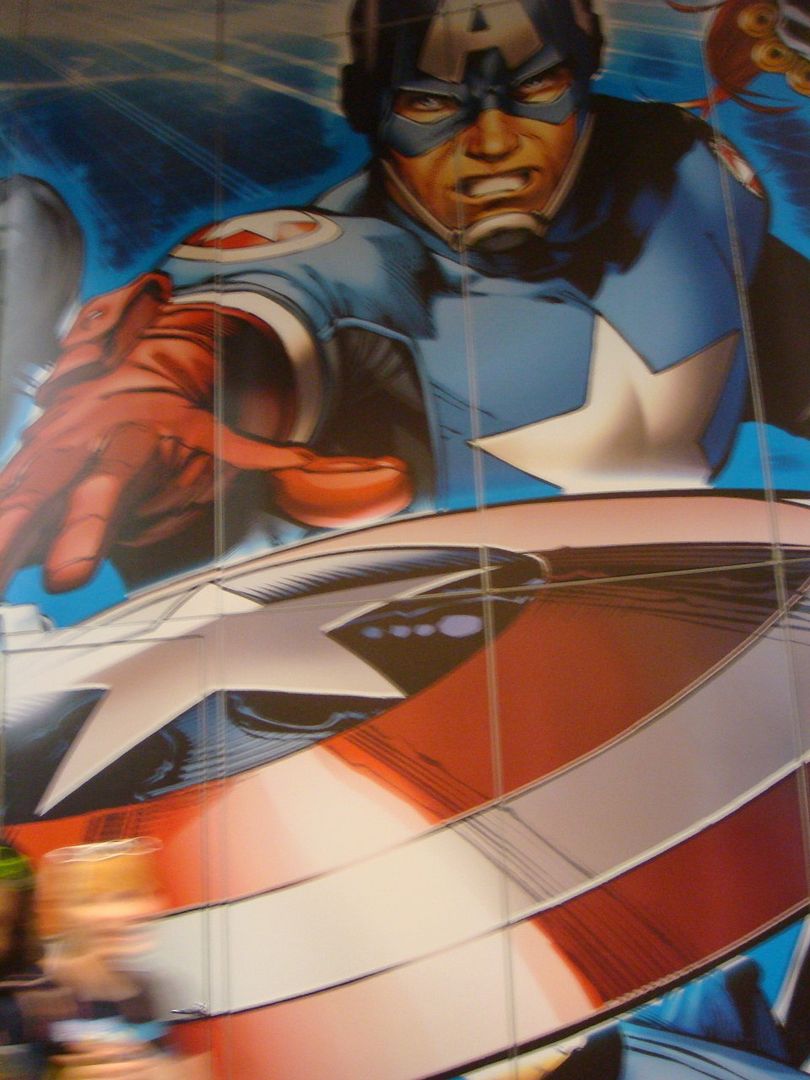
The two constants at Comic-Con International: San Diego -- much as in comics themselves -- are continuity and change. Sometimes, the two go hand in hand. For instance, at this year's Comic-Con, I commissioned a sketch from Wendy Pini, from whom I commissioned a sketch at my first Comic-Con, 31 years ago. And considering the passage of decades, the price wasn't much different: $40 now, compared to $10 then. But while for years convention sketches have been paid for in cash, or on occasion by check, I paid for this one (and several other purchases in the Dealer's Room) by credit card, signing my name with my fingertip on Richard Pini's iPhone. These two themes of continuity to past conventions, and changes, played themselves out over and over during the four-and-a-quarter-day con.
Along with the Pinis, many creators I met or saw at the con three decades ago can still be seen there. Folks like Marv Wolfman, Len Wein, Mark Evanier (who hosted a baker's dozen panels, as he has for years), my old friend Phil Yeh (whom I first met at a Seattle convention nearly 30 years ago), Brent Anderson, and others still come to the con to meet their fans and talk about their craft.
Many changes related to the Con's swell of popularity in recent years, fueled by its reputation as a source of word-of-mouth promotion for the superhero movies and other film and TV projects that relate to Comic-Con's pop culture sensabilities. For instance, for years Amy and I have purchased our memberships for the following year's convention onsite. In the past, this involved walking up to a table in the main lobby, perhaps waiting in a line one or two people long, and picking up the memberships. Last year was a bit more complicated: We bought the memberships on the last day of the Con, and because the Preview Night passes were being sold only at the convention (and because memberships started selling out a few years ago, for the first time), the line was fairly long. This year, the process of getting the next year's membership devolved into madness. The passes to be sold at the convention were apportioned between each day; and on each day the passes were sold only between 8 a.m. and 10 a.m. Those who lined up before the sun came out were able to buy 4-day passes with the Preview Night, at an unprecedented price of $175 each. We got into line shortly after 7 a.m. on the second day of the con; waited nearly four hours; and were still unable to get either the Preview Night feature or four-day passes. Instead, we got four one-day passes each.
Eventually, the sheer effort necessary to obtain memberships will likely cut down on the number of memberships sold, resolving the problem. Or the con may expand -- although it already fills the convention center and slops over to the two closest hotels.
Major movie studios' participation in the con also changed. Disney/Marvel and Warner Brothers/DC made headlines by declining to put on presentations for their upcoming comics-related films, leading to commentary that Comic-Con might be losing its buzz as a tastemaker.
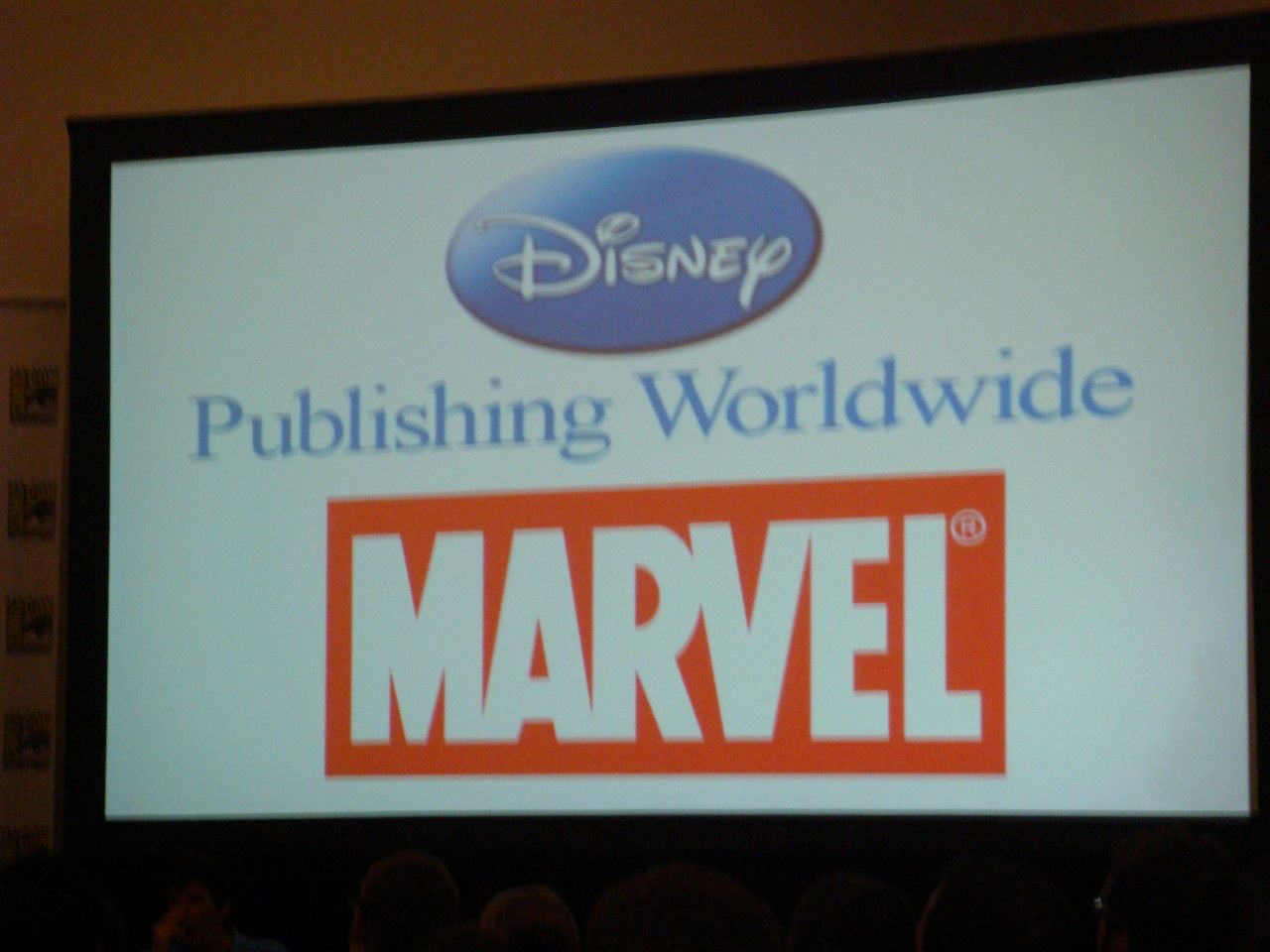
We held on to some hope that this trend would allow us to actually attend some of the movie and TV presentations we had been unable to see for the last few cons, since they required lining up for so long that we'd miss a major portion of the convention if we tried to attend them. But unfortunately, we did not get into Hall H, or (for the first time) Ballroom 20, the mecca for TV programming. The closest we came to media panels was to attend the highly-entertaining panel put on by Penn & Teller to advertise their upcoming TV show on Discovery. (To do so, we sat through a mildly-interesting panel on Voltron.)

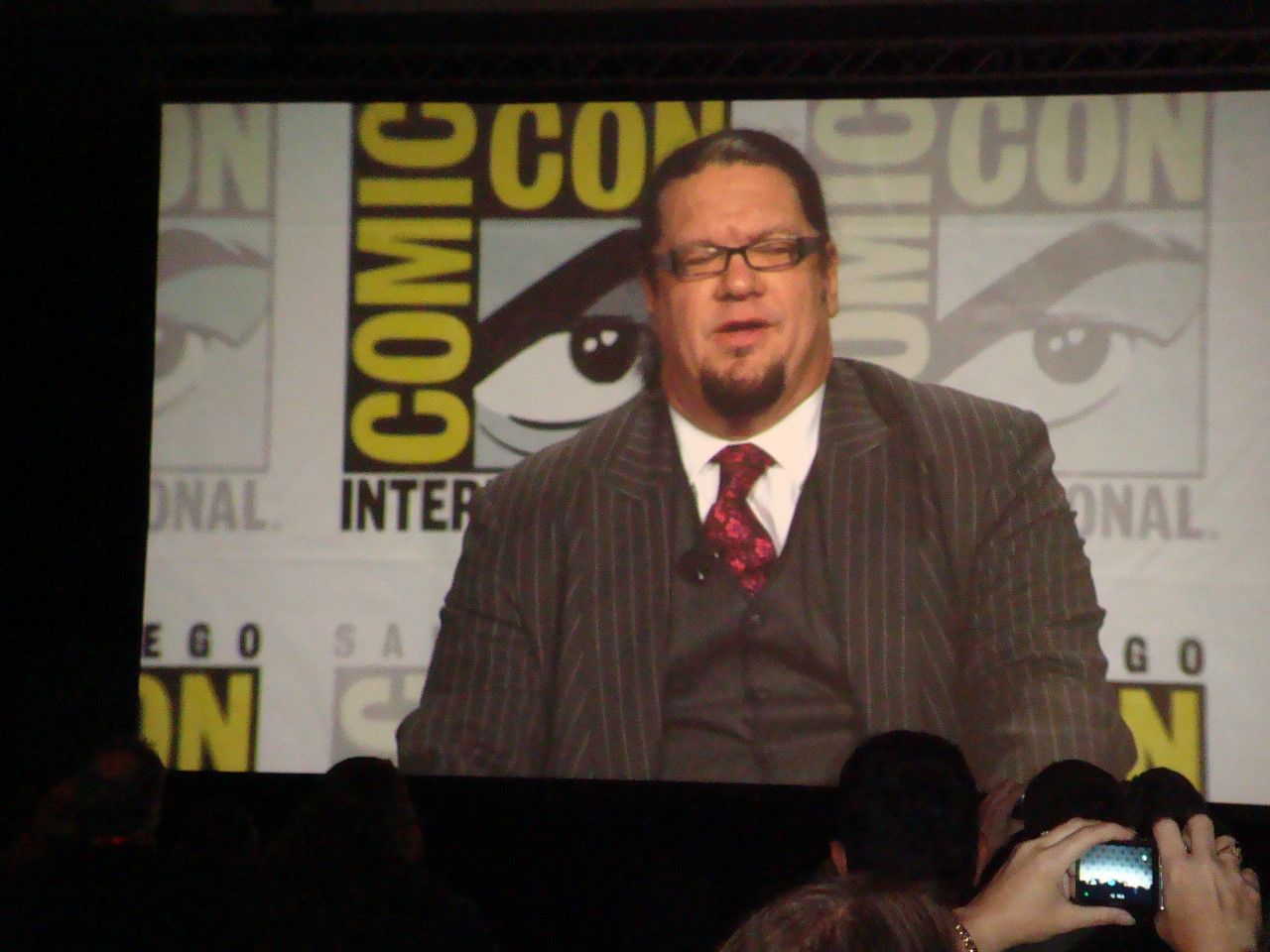
Further, Marvel did not abandon the con entirely. Notably, they premiered CAPTAIN AMERICA: THE FIRST AVENGER at a nearby theater, a day before it opened nationwide, leading to lots of goodwill from con goers (particularly in response to the trailer after the opening credits for next year's highly-anticipated AVENGERS movie.
And Marvel tricked out its booth in the Dealers' Room with a stunning recreation of SHIELD headquarters from the Avengers movie, complete with models in SHIELD jumpsuits:

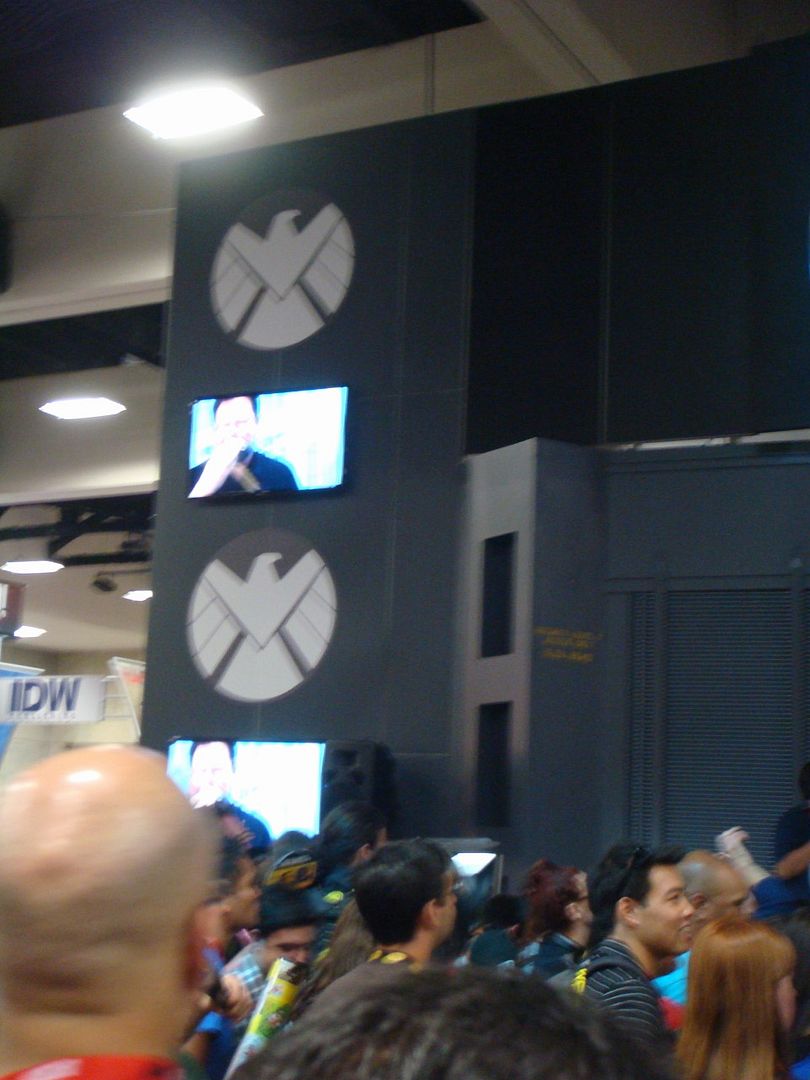
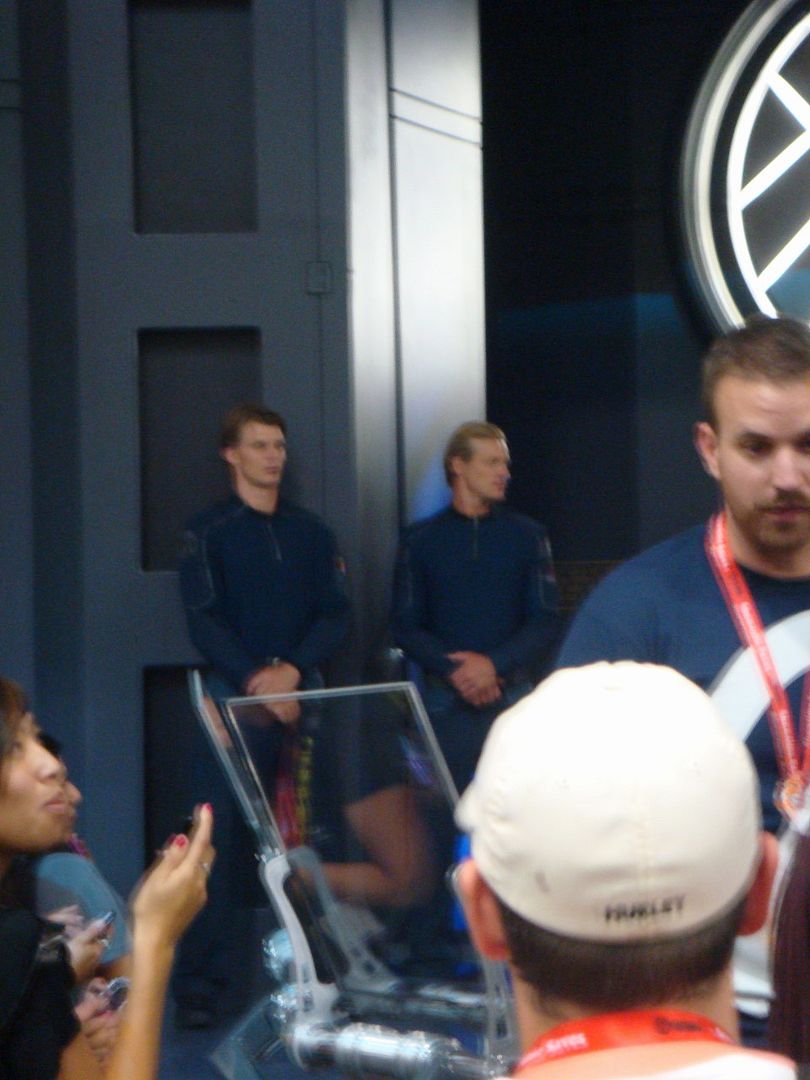
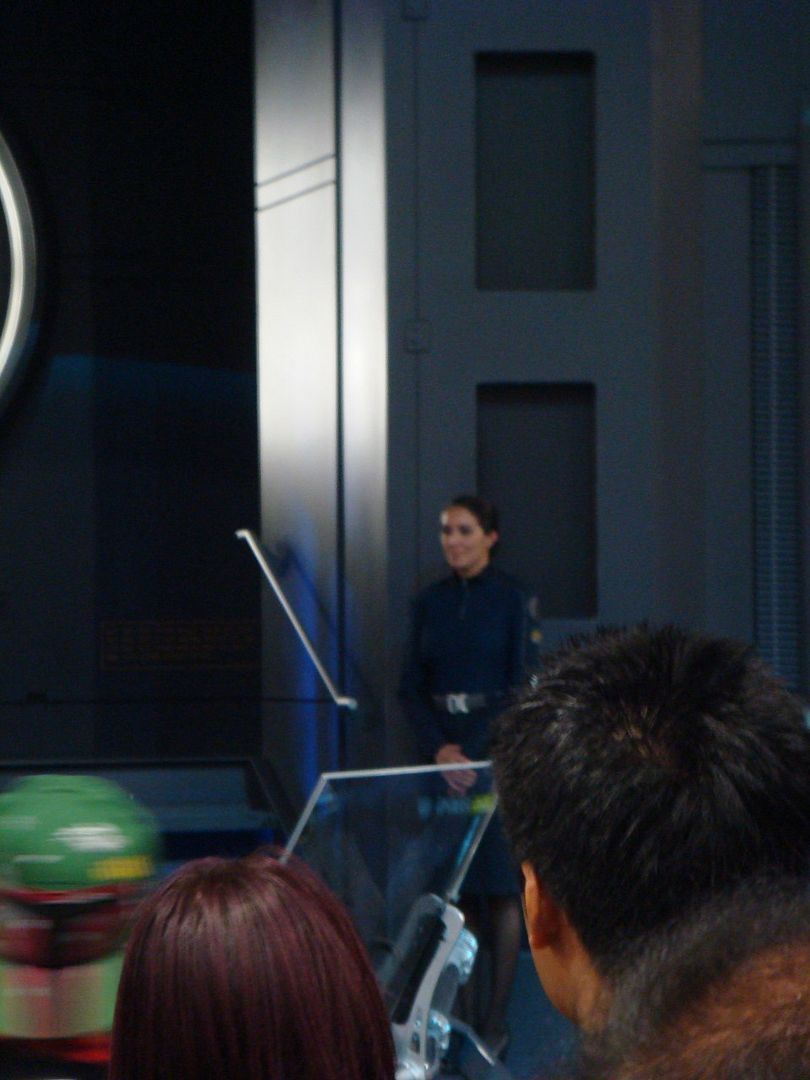
And DC Comics was certainly represented at the con, with T-Shirts and con bags emblazoned with Jim Lee's redesign of the Justice League, and high-rises decked out with supergraphics advertising the upcoming Batman video game, Arkham City.
But what I really come to Comic-Con for are the comic-book creators, and the panels on which they talk about their pasts and future.
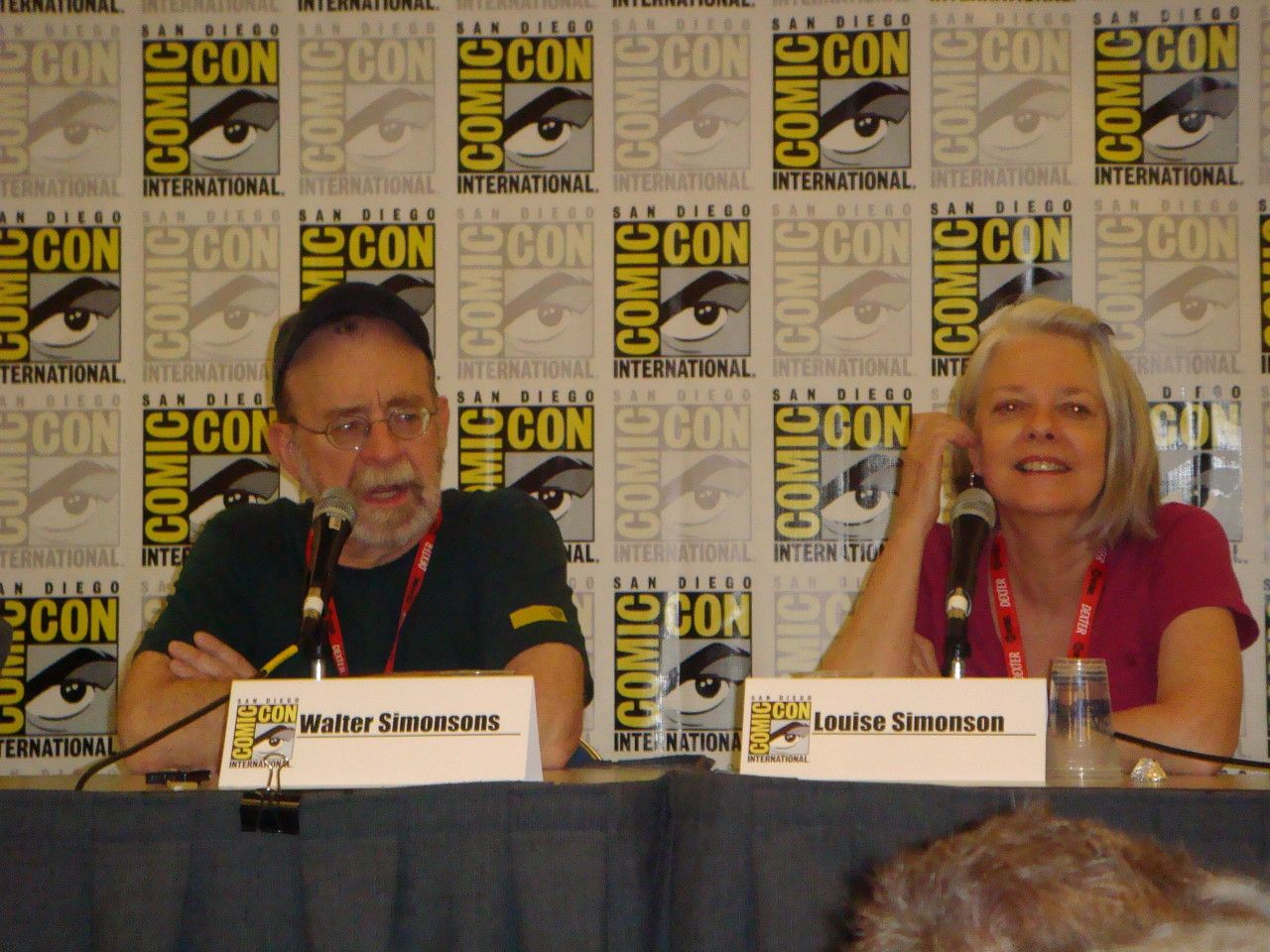
Indeed, since by Friday afternoon I had not attended any comics panels (having spent most of Thursday attending the Captain America screening, and Friday morning in the hideous pre-reg line for 2012), immediatly upon finishing the pre-reg and getting lunch at one of the handy food trucks a couple of blocks away, I insisted on sitting through three comics-oriented panels in a row: A tribute to the multi-decade career of the recently-deceased artist Gene Colan; a discussion of the comics fanzines of the 1960s; and the '70's panel, a tribute to the somewhat-staid, somewhat-experimental comics of that period. Interestingly, one of the con guests of honor, Roy Thomas, was on each of those panels.
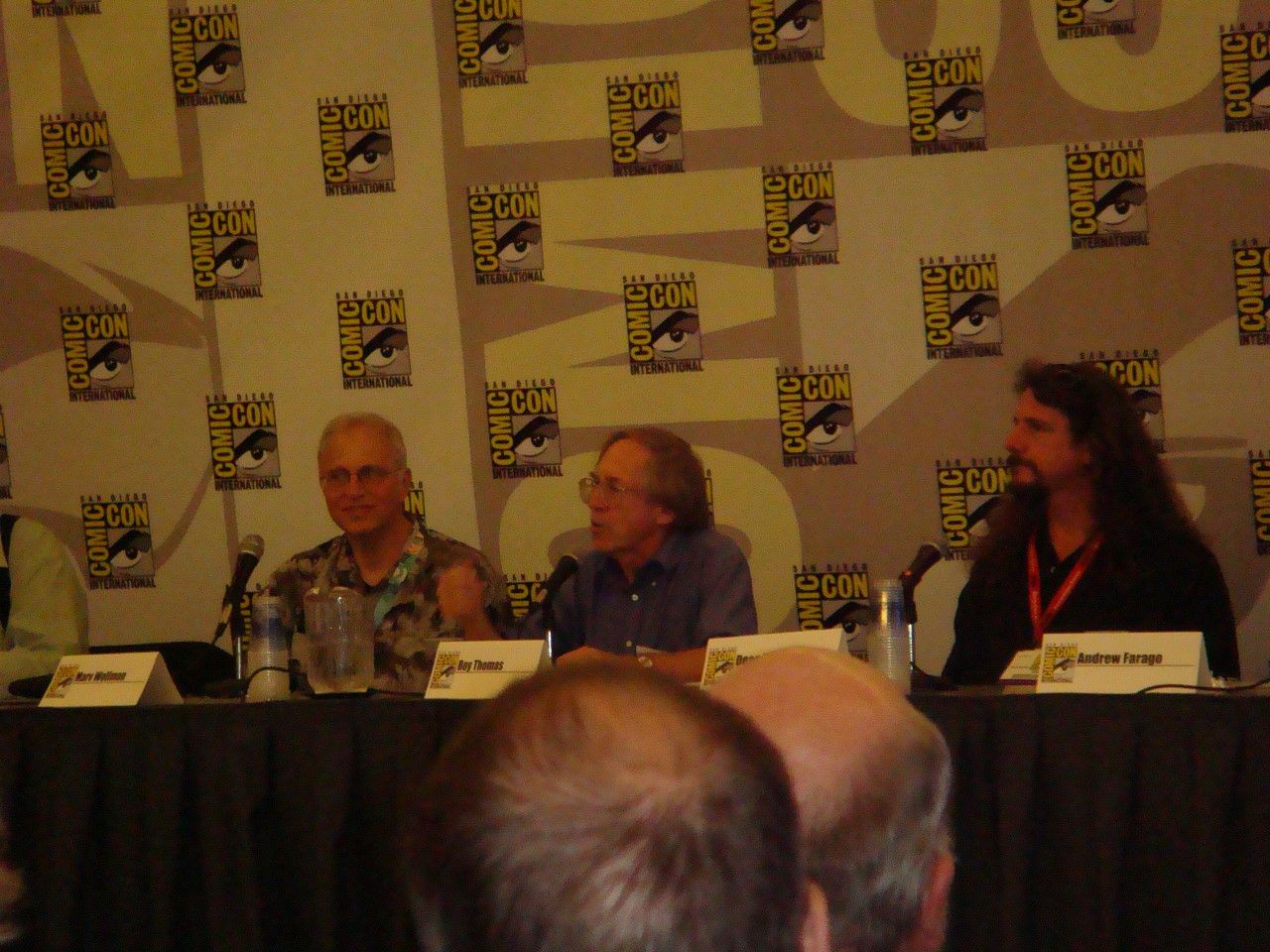

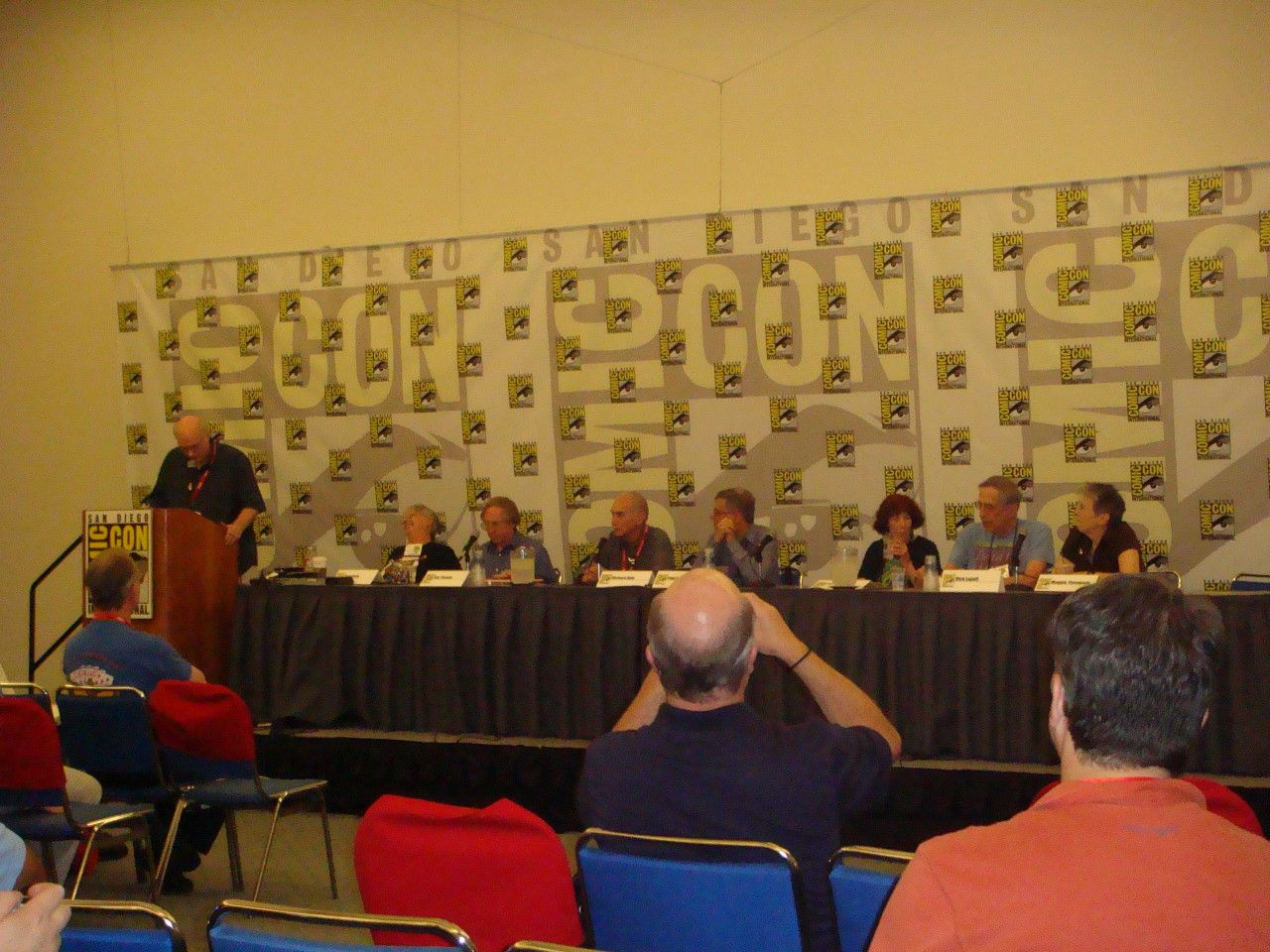

Saturday, as in previous years, was steampunk day. The steampunk panel was put in a much larger room than in previous years, yet filled up completely -- showing that interest in the subculture is not waning. And that afternoon, we once again had a big steampunk gathering on the mezzanine of the convention center, filled with amazing outfits and gadgets.
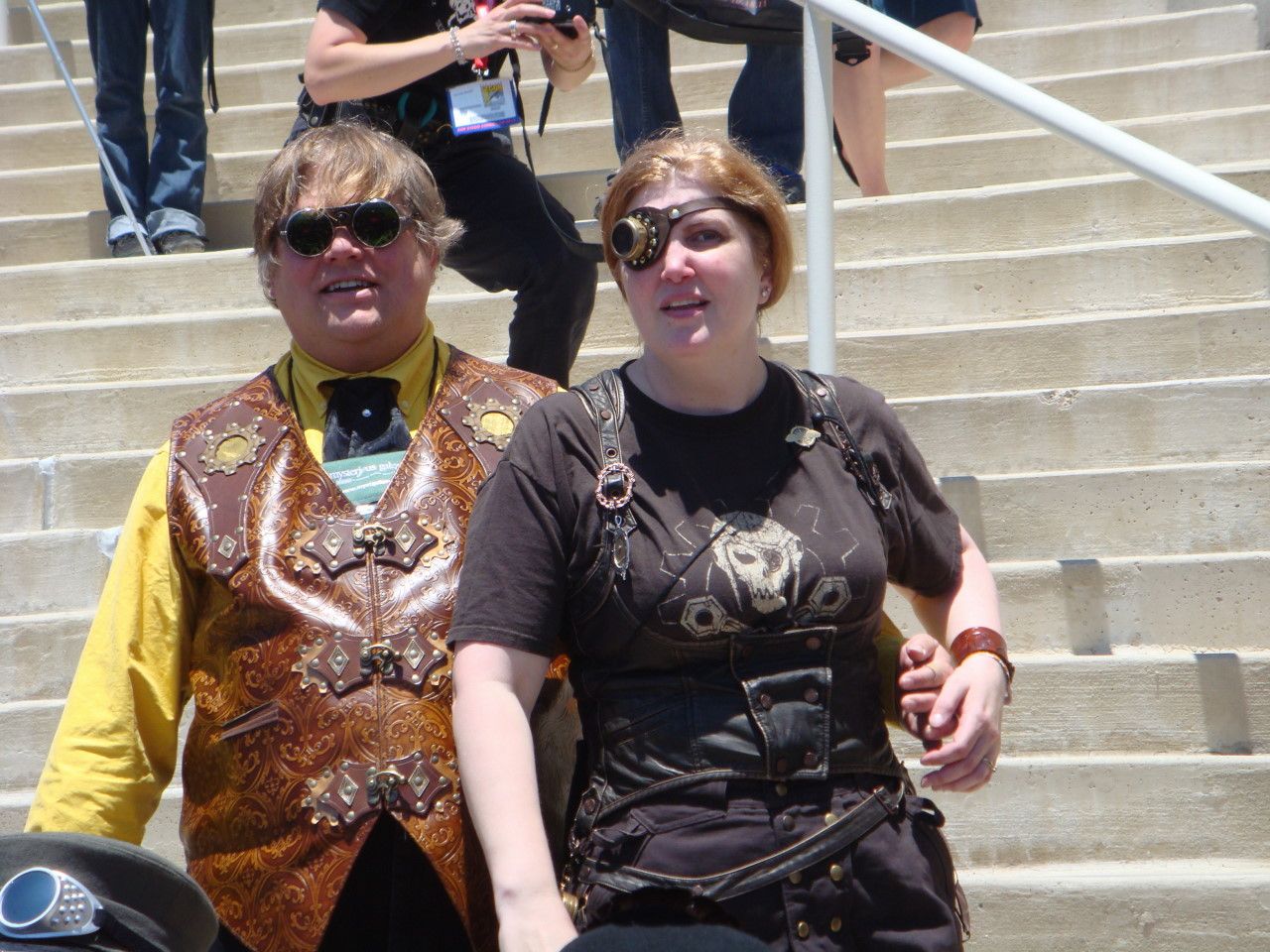
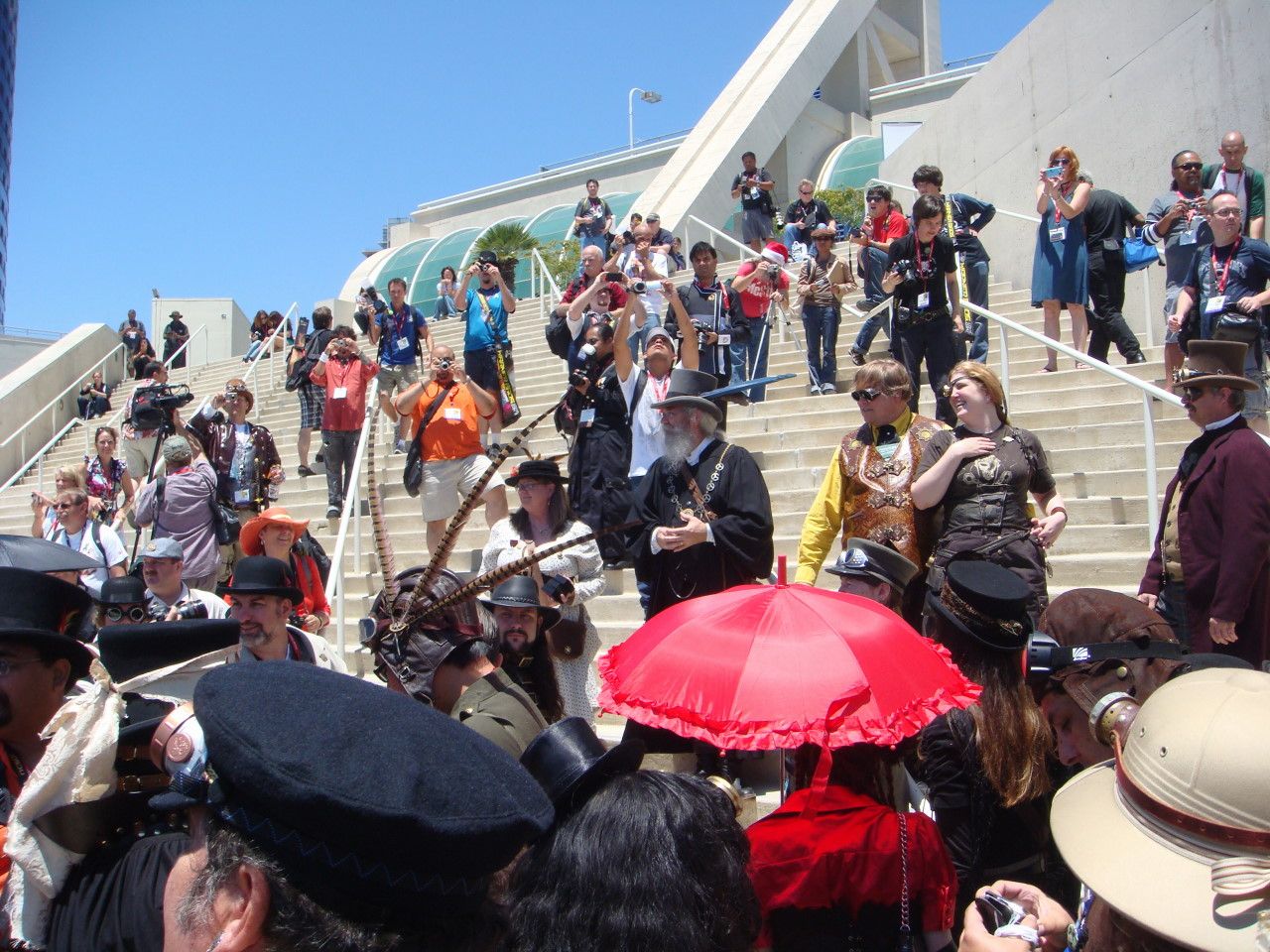
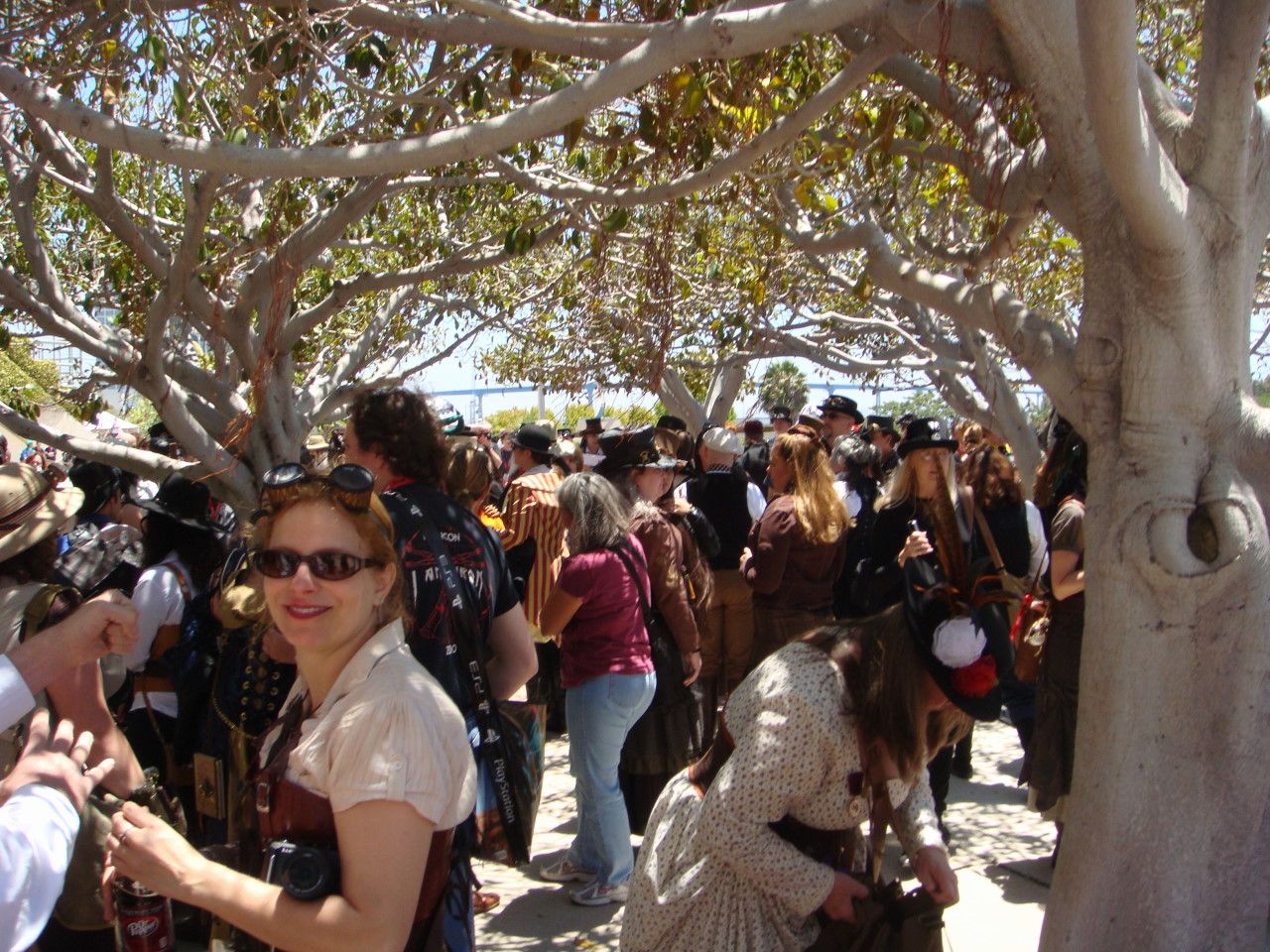
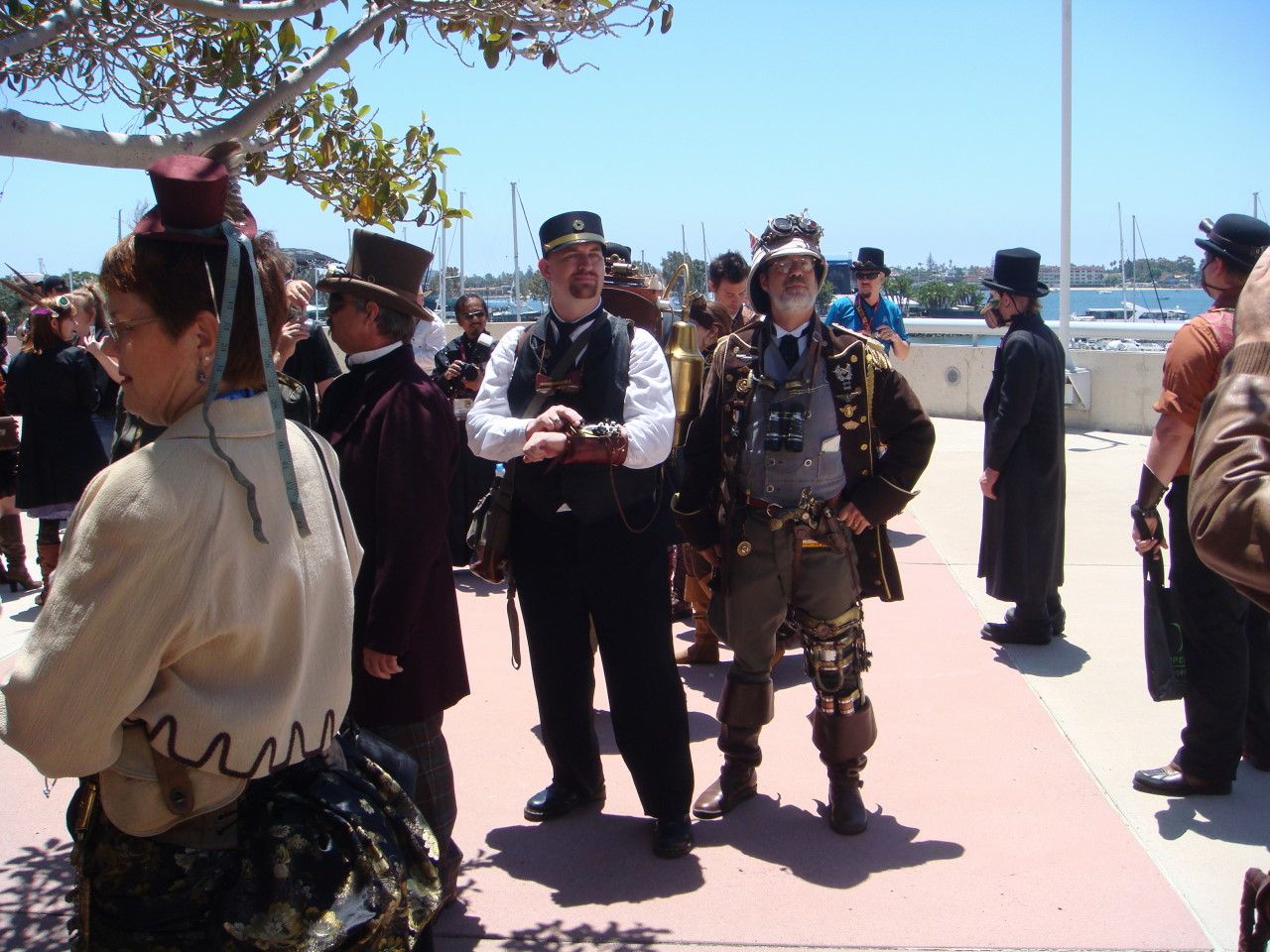

We finished out Saturday watching the masquerade -- not watching it live, nor at the party under the sails on top of the center, but in yet another ballroom where it was being simulcast. I suspect that between the three venues, everyone who wanted to see the masquerade had a chance to do so.
Sunday is generally our day for packing up, attending a few final panels, and doing a last sweep of the Dealers' Room. This customarily includes visits to the booths of Comic Relief and Bud Plant. But there again, change was in store. Comic Relief of Berkeley went out of business last year. And Bud Plant, after 41 years selling comics and art books, is retiring and selling his business. We went to his (much diminished) table, bought some books and chatted with Mr. Plant, but the atmosphere around his table was filled with the sensation of time passing.
We will be coming back to Comic-Con next year. (After what we went through to get passes for next year, we'd damn well better.) And we'll probably have a good time, like we did this year. But we'll probably be aware next year, as we were this year, that you can never go back to a Comic-Con you went to in the past, because, for better or worse, Comic-Con must always change.
Here are some parting miscellaneous photos of the con. More next year.

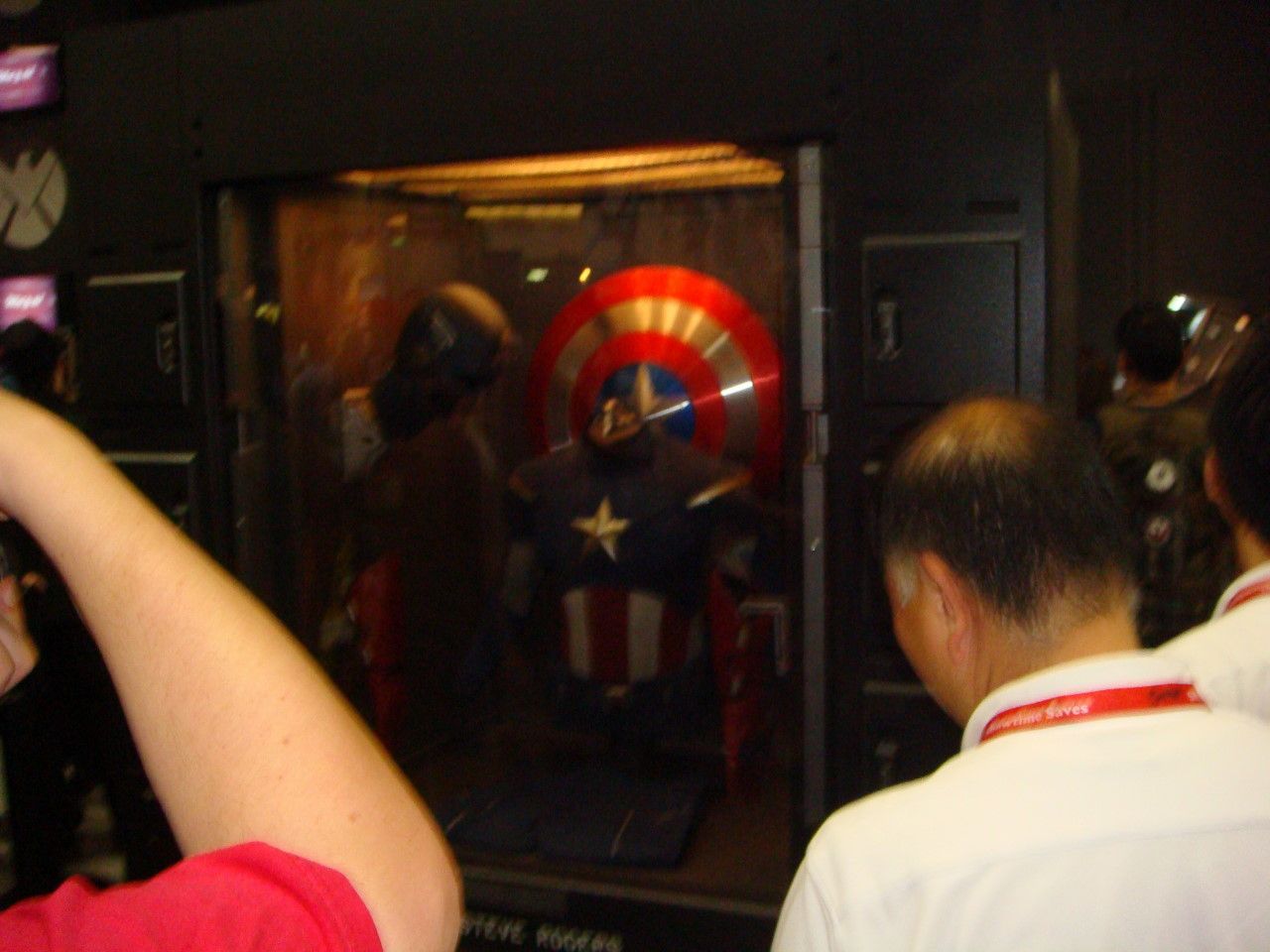
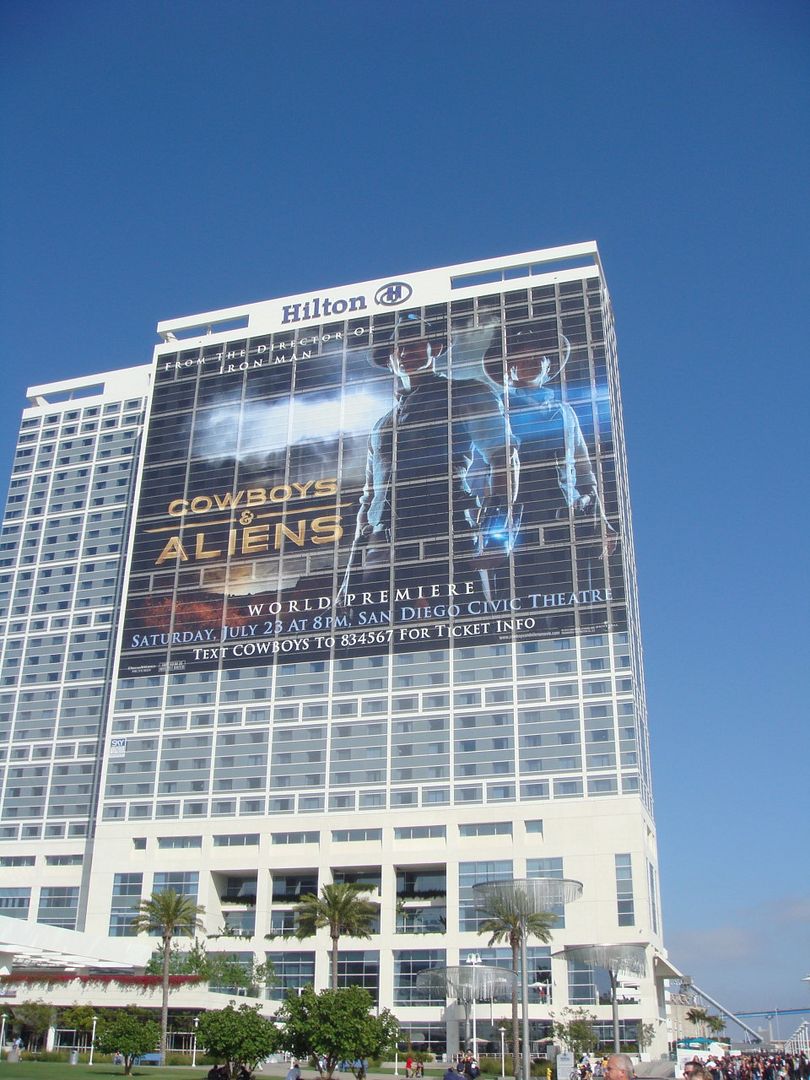
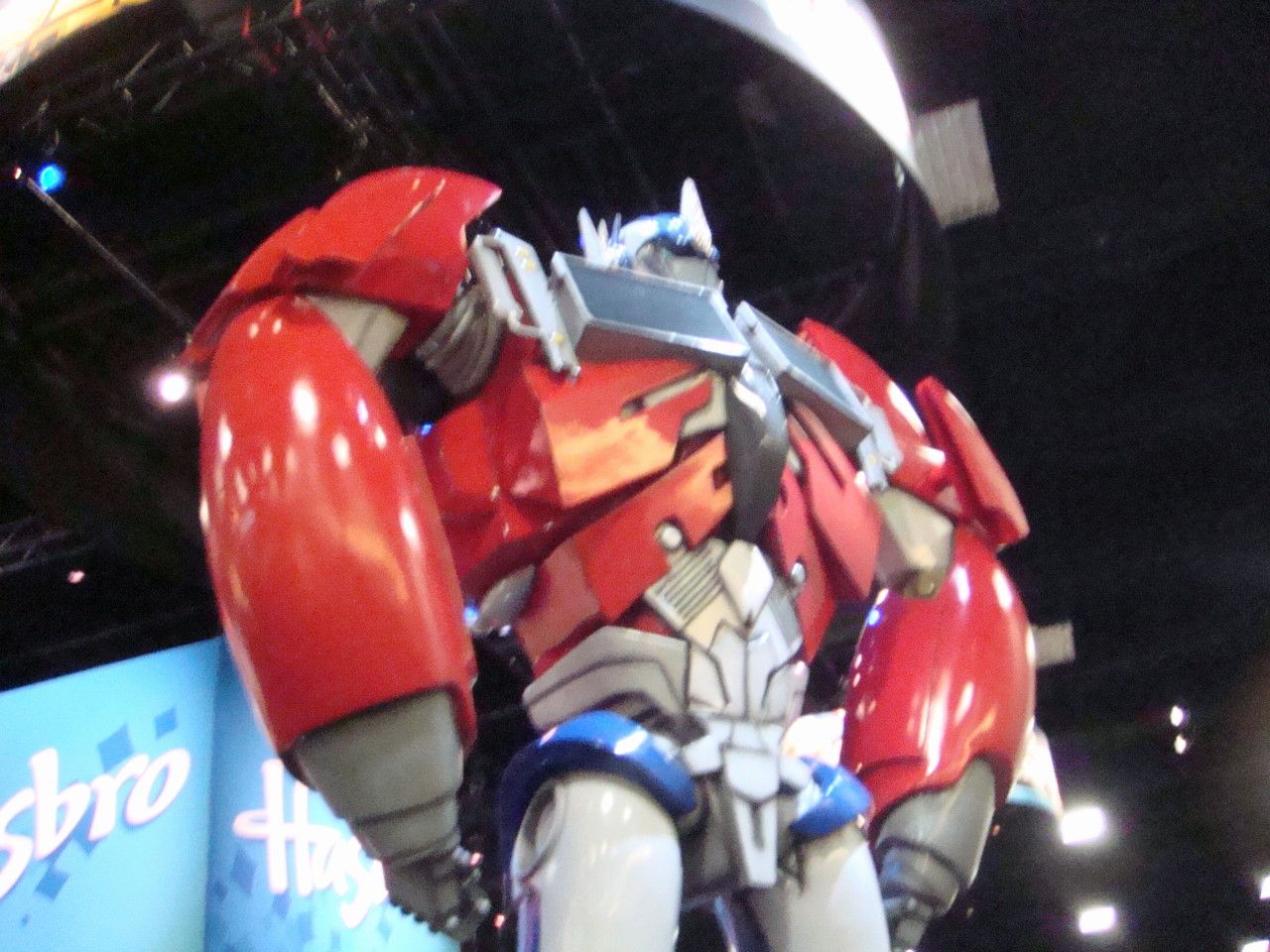
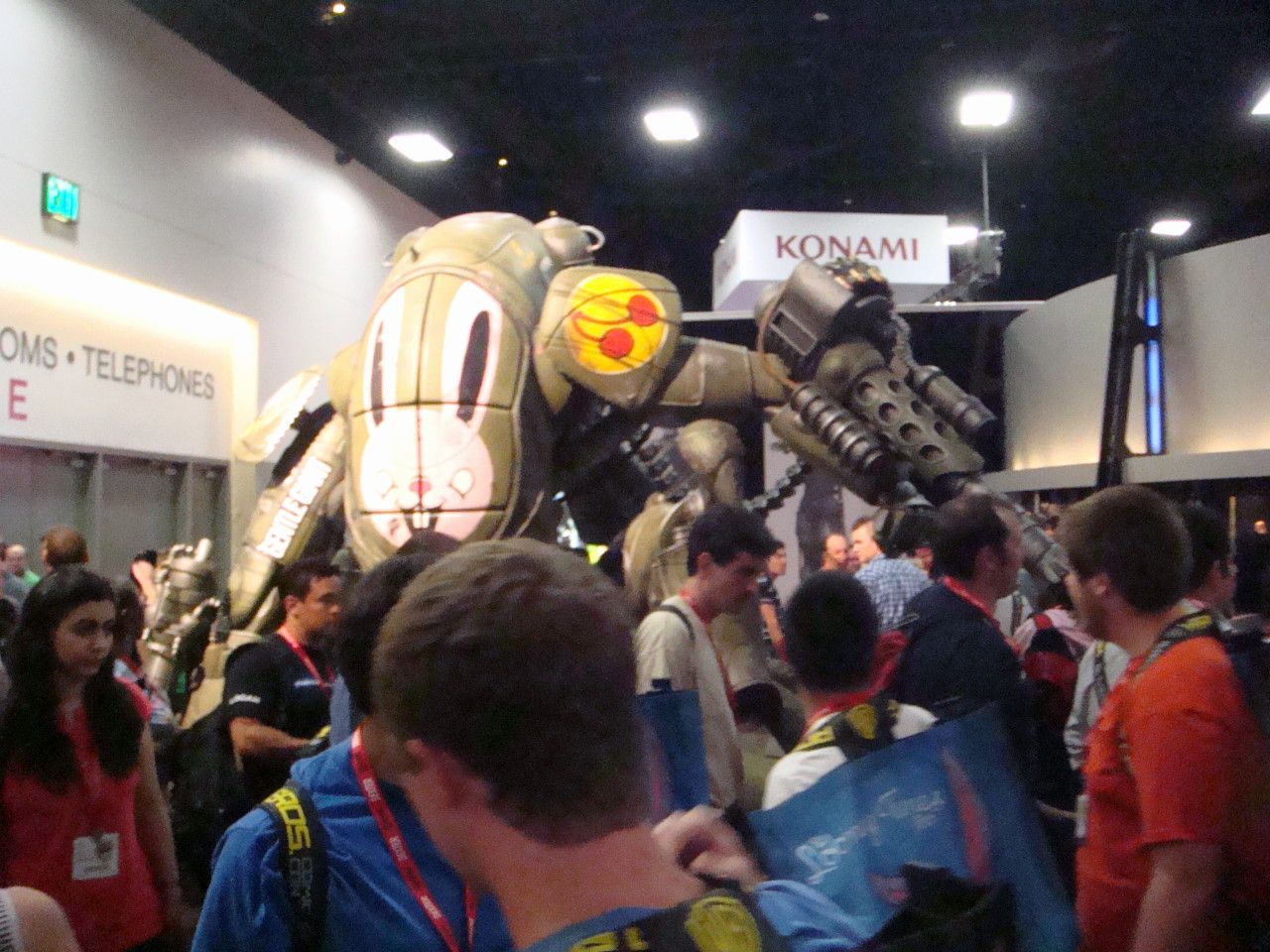
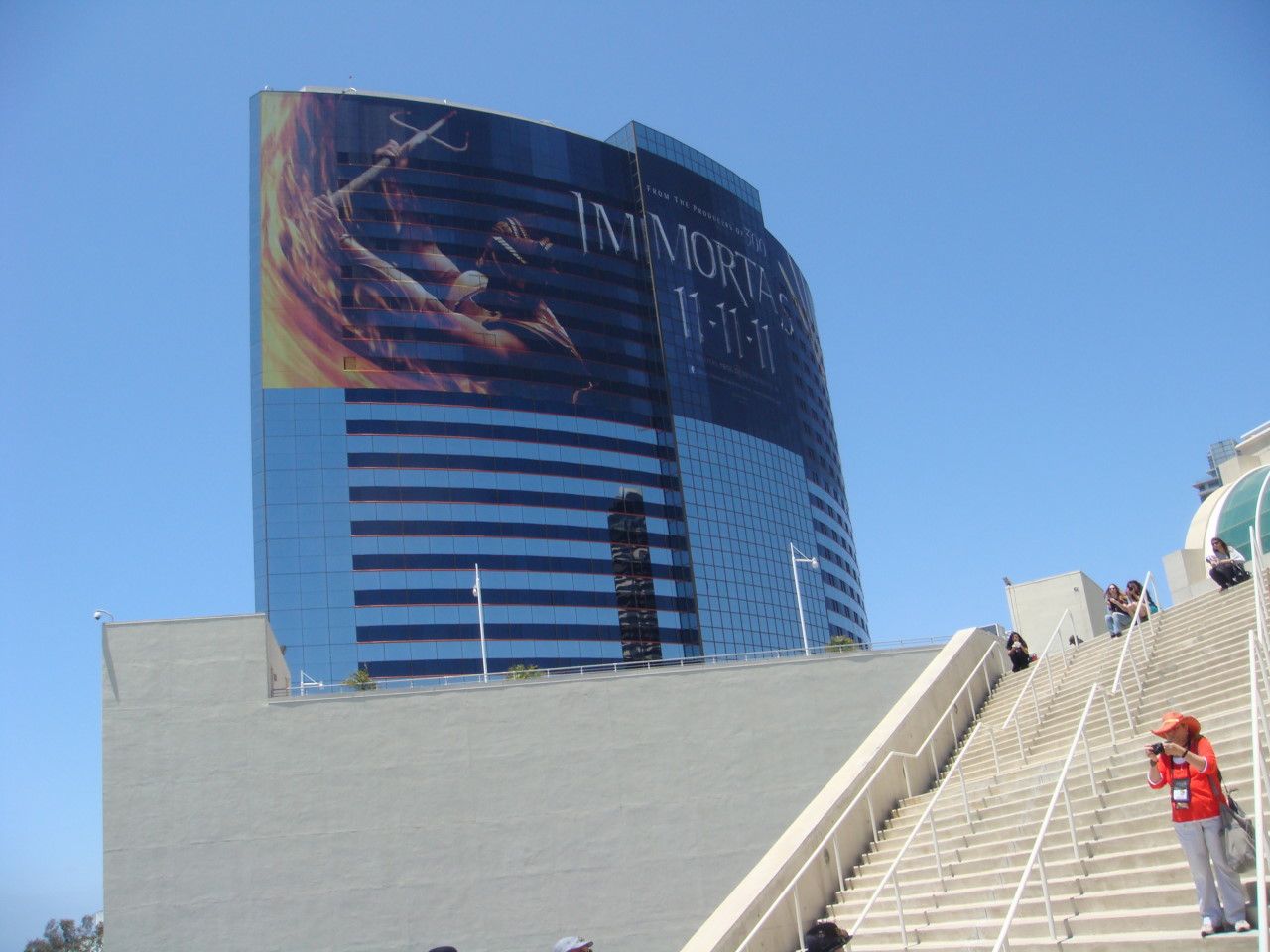
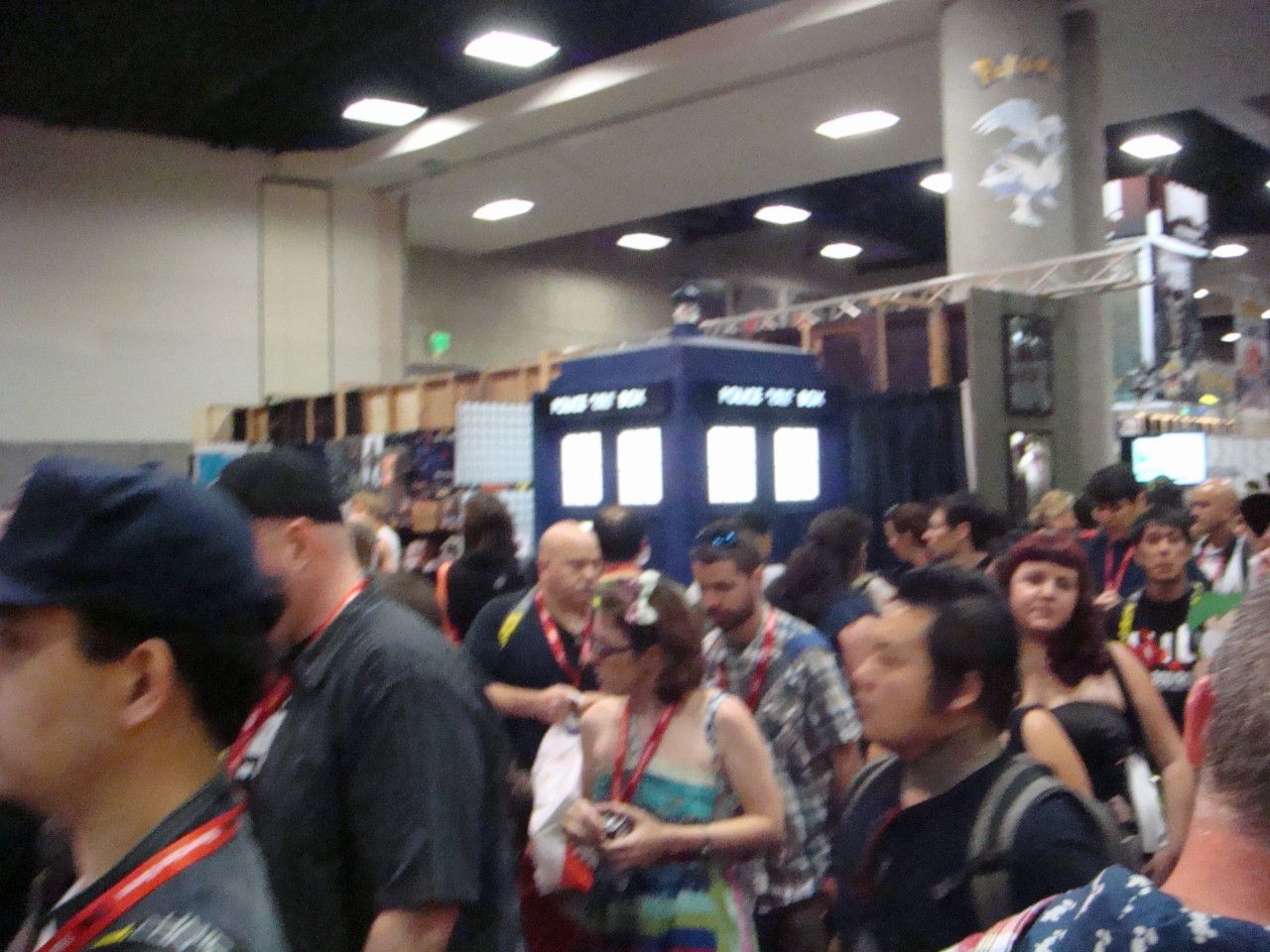
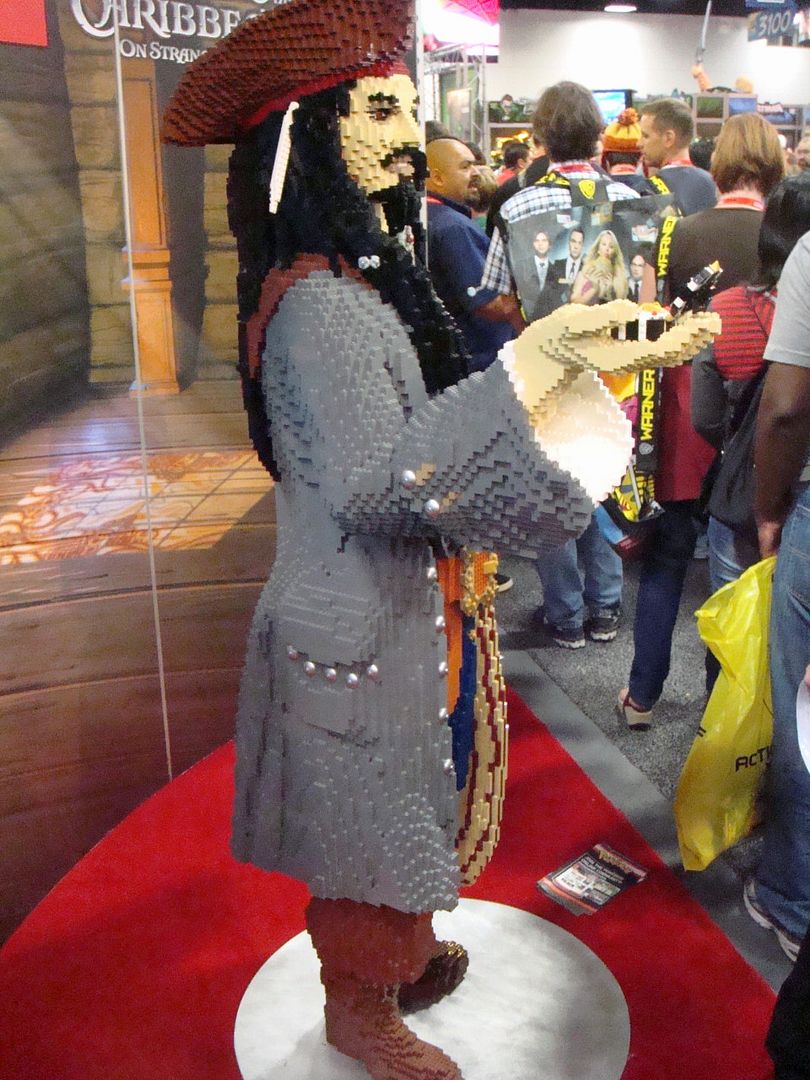
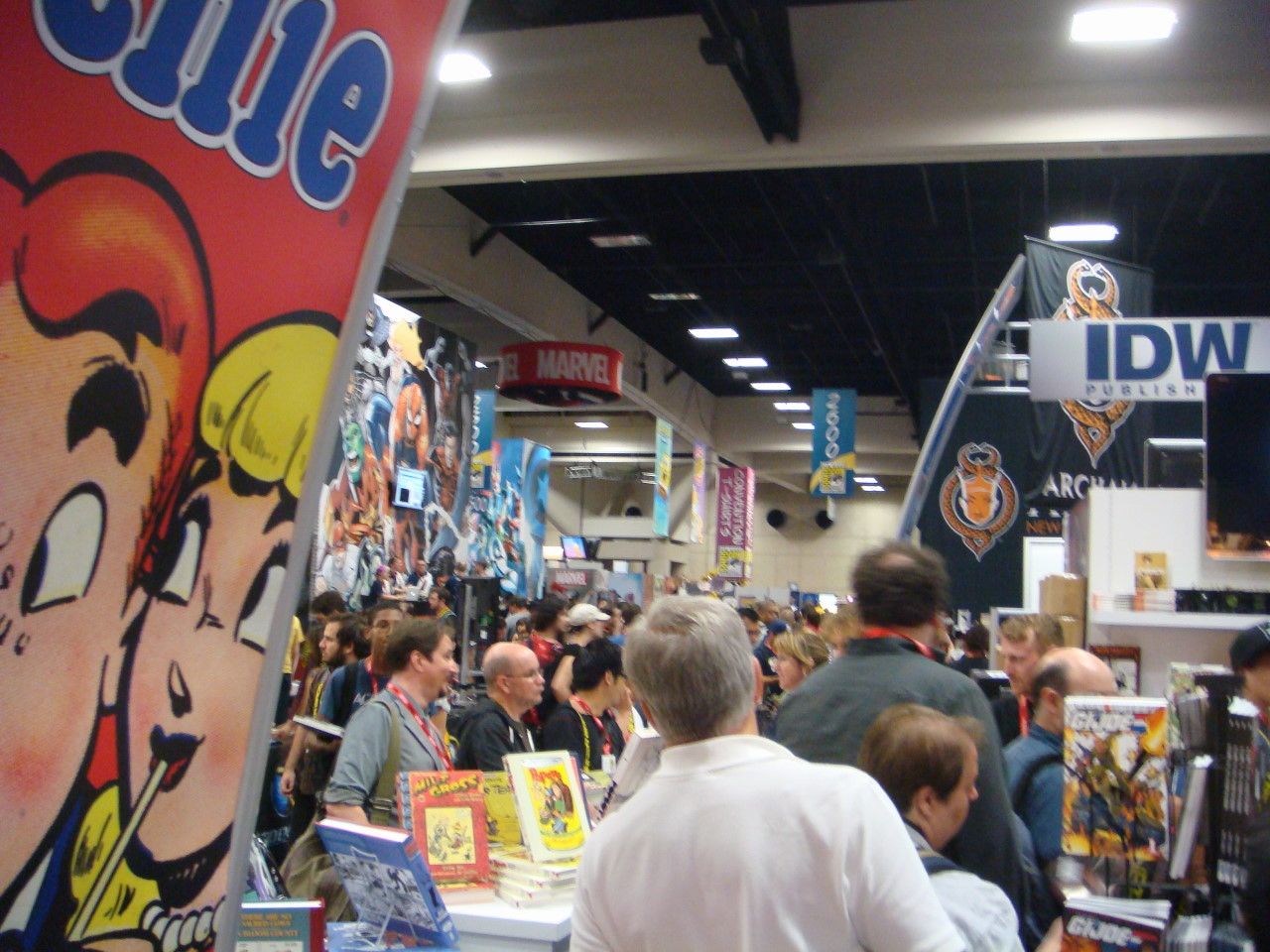

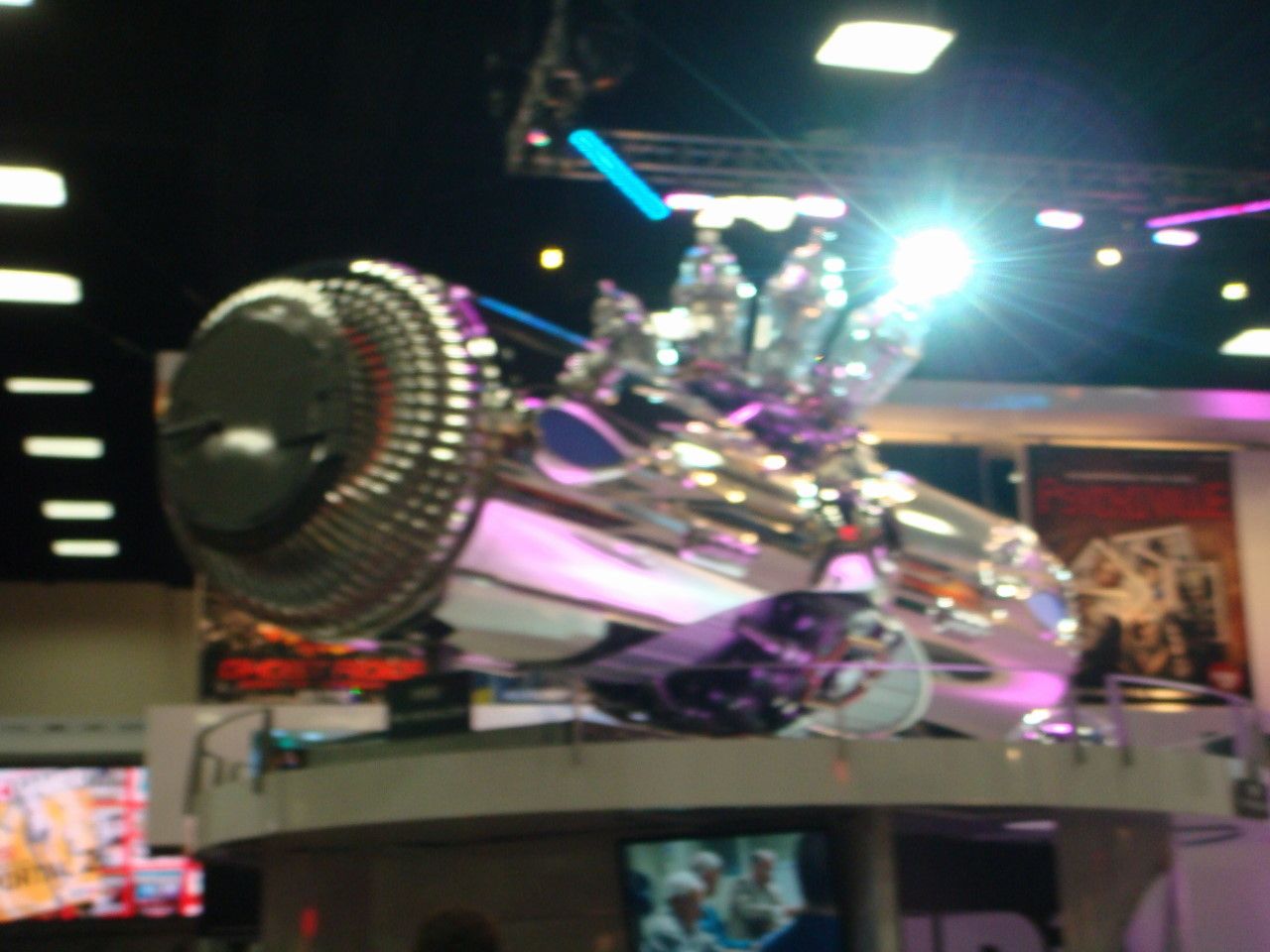

Thursday, July 21, 2011
Comic-Con Preview Night
We managed to get to Comic-Con Wednesday in time to enjoy a full preview night -- which, although limited to those who got 4-day passes plus the preview night (i.e., those who pre-reg'ed at last year's con) was stuffed to the gills with eager fans spending at a pace that belied the dire economy. Photos at Photobucket.
Thursday: The Captain America movie.
Thursday: The Captain America movie.
Sunday, July 17, 2011
One Last Enchantment
When we watched the first Harry Potter movie in 2001, I concede that I had my doubts that the producers would be able to carry out their plans to adapt all of the planned HP novels, with the original cast. The first film was a big-budget extravaganza; and such productions take huge investments of time and money to produce. While the first film did extremely well at the box office, there was no guarantee that future films would duplicate its success (indeed, several of the movies earned less than the opening one, despite rising ticket prices), or that interest in the books and movies would continue to support film projects. Most of all, there was the challenge of the cast. Children grow up, and even when watching a fantasy film an audience would find it hard to accept a 30-year-old as a boy wizard. Moreover, a good child actor isn't necessarily a good adult actor. And children who act in films often put away such childish things as adults, and drop out of acting. The producers therefore had to craft seven (or, as it turns out, eight) high-budget, high-spectacle movies within a short enough time frame that they wouldn't lose their leads.
The films that have tried to duplicate the HP formula in the last several years have shown that this is no easy task. Numerous movies based on successful young adult series, such as the Lemony Snicket books or Phillip Pullman's series -- did not progress past the first film. Even the Narnia movie series, which met generally favorable reactions at the box office (especially the first movie), switched distributors, and may not make it past the third film.
Yet the HP producers pulled it off. Doing so took vast amounts of money (although the movies and related merchandise produced mountains of cash in return), multiple directors, and a cast that managed to grow into its roles. But the second part of THE DEATHLY HALLOWS opened this weekend, to spectacular box office (preliminary estimates are that the opening weekend generated nearly $350 million worldwide)and glowing reviews.
And, in fact, the final movie is one of the best. Although it would be impenetrable to a new viewer (or anyone who didn't see the first part), the movie is both a slam-bang action epic, stuffed with spectacular set pieces, and an emotionally-satisfying end to the series. The filmmakers did this not only by dividing the final novel adaptation into two parts (letting the story breath) but finding the dividing line in tone between the sections of the novel and sending the second film on a headlong trajectory that doesn't let up until the final denouement. Further, while retaining the most important beats of the story -- which, like most of the Potter novels, is essentially a game-like quest for puzzle pieces -- the filmmakers reworked scenes to make them more cinematic. In particular, the scene in which (spoiler) Harry and a weakened Voldemort finally go wando-a-wando is not the chatfest it is in the book. Instead, it is a headlong fight that calls to mind the climactic castle swordfights of swashbucklers from Hollywood past.
The result is unprecedented. The closest analogue may be the James Bond film series -- but that series survived only by changing casts and tone constantly; and it did not deal with the quandary of child actors.
So, what now? I don't know if J.K. Rowling will succumb to what no doubt is enormous pressure to turn out further adventures (perhaps some novels about (spoiler) those rambunctious Potter and Weasley cousins and their misadventures at Hogwarts); but even if she doesn't, I doubt this is the final adaptation of this world. Past works of British fantasy, such as the Lord of The Rings trilogy and those Narnia books, have been adapted into multiple live-action and animated versions, not to mention radio dramas. I wouldn't be surprised to someday see a BBC TV series faithfully adapting the novels, with a new cast; or a series of graphic novels illustrating the adventures in slavish detail.
In any event, we have seven books and eight movies (not to mention various ancillary works Rowling has written up) and unprecedented success in translating a young adult series to film.
The films that have tried to duplicate the HP formula in the last several years have shown that this is no easy task. Numerous movies based on successful young adult series, such as the Lemony Snicket books or Phillip Pullman's series -- did not progress past the first film. Even the Narnia movie series, which met generally favorable reactions at the box office (especially the first movie), switched distributors, and may not make it past the third film.
Yet the HP producers pulled it off. Doing so took vast amounts of money (although the movies and related merchandise produced mountains of cash in return), multiple directors, and a cast that managed to grow into its roles. But the second part of THE DEATHLY HALLOWS opened this weekend, to spectacular box office (preliminary estimates are that the opening weekend generated nearly $350 million worldwide)and glowing reviews.
And, in fact, the final movie is one of the best. Although it would be impenetrable to a new viewer (or anyone who didn't see the first part), the movie is both a slam-bang action epic, stuffed with spectacular set pieces, and an emotionally-satisfying end to the series. The filmmakers did this not only by dividing the final novel adaptation into two parts (letting the story breath) but finding the dividing line in tone between the sections of the novel and sending the second film on a headlong trajectory that doesn't let up until the final denouement. Further, while retaining the most important beats of the story -- which, like most of the Potter novels, is essentially a game-like quest for puzzle pieces -- the filmmakers reworked scenes to make them more cinematic. In particular, the scene in which (spoiler) Harry and a weakened Voldemort finally go wando-a-wando is not the chatfest it is in the book. Instead, it is a headlong fight that calls to mind the climactic castle swordfights of swashbucklers from Hollywood past.
The result is unprecedented. The closest analogue may be the James Bond film series -- but that series survived only by changing casts and tone constantly; and it did not deal with the quandary of child actors.
So, what now? I don't know if J.K. Rowling will succumb to what no doubt is enormous pressure to turn out further adventures (perhaps some novels about (spoiler) those rambunctious Potter and Weasley cousins and their misadventures at Hogwarts); but even if she doesn't, I doubt this is the final adaptation of this world. Past works of British fantasy, such as the Lord of The Rings trilogy and those Narnia books, have been adapted into multiple live-action and animated versions, not to mention radio dramas. I wouldn't be surprised to someday see a BBC TV series faithfully adapting the novels, with a new cast; or a series of graphic novels illustrating the adventures in slavish detail.
In any event, we have seven books and eight movies (not to mention various ancillary works Rowling has written up) and unprecedented success in translating a young adult series to film.
Saturday, July 09, 2011
AX 2011: Virtual Girls and Rare Dubs
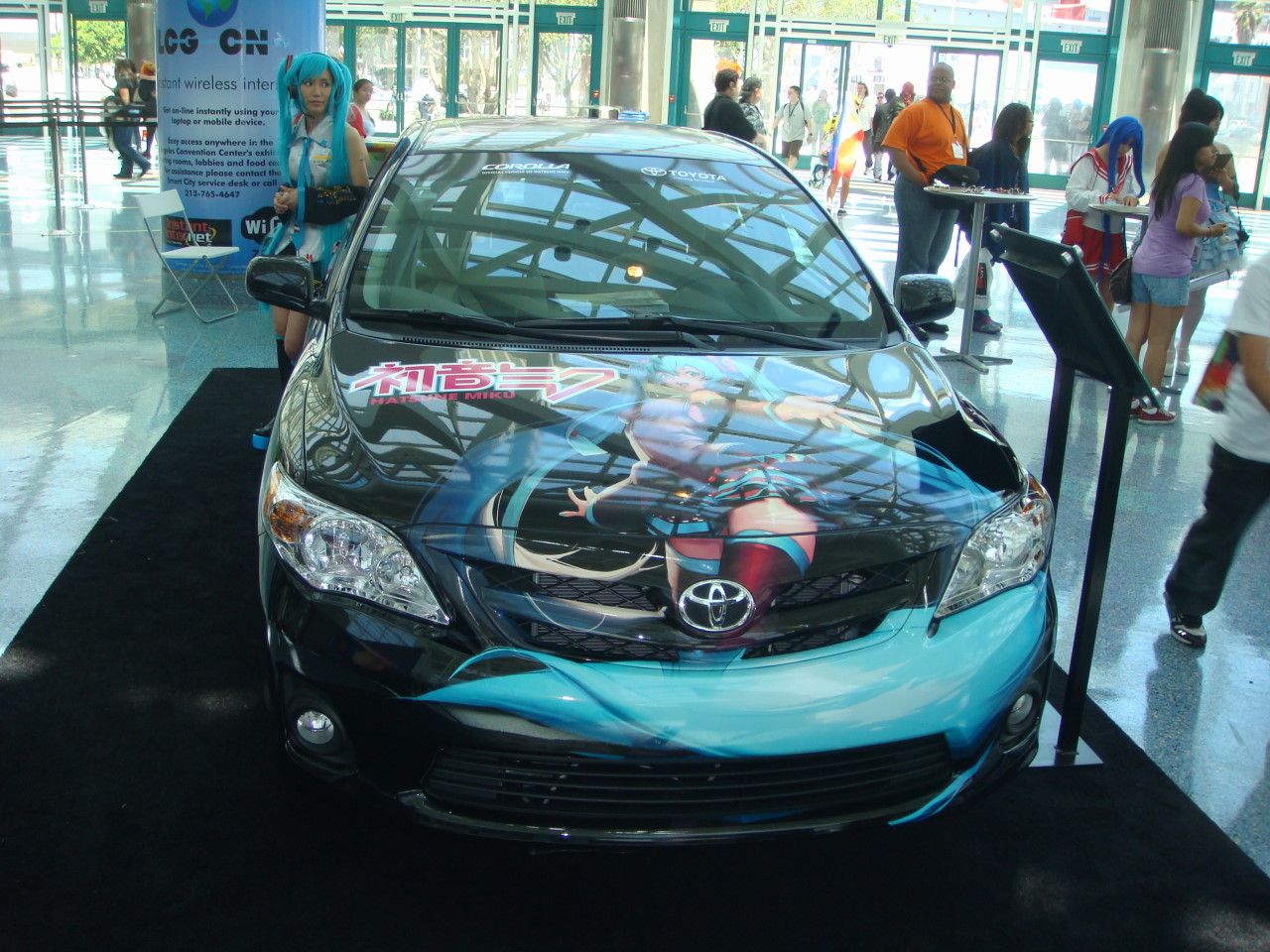
Fans of 1980's-era Japanese animation may recall the 1985 anime MEGAZONE 23, in which Eve, young female pop idol in 1980's Tokyo, turns out to be (spoiler) a holographic projection -- the manifestation of the artificial intelligence that runs a generation ship mocked up to look like 1980's Tokyo.
Attendees of this year's Anime Expo, held last weekend at the Los Angeles Convention Center, could not help but be reminded of Eve as they beheld the face of this year's AX: Hatsune Miku.

Ms. Hatsune, you see, is a virtual pop idol -- a character in the Japanese Vocaloid software, which allows songwriters to hear their songs sung by sythesized voices. With Hatsune Miku, the creators of the Vocaloids (who were guests at the convention) went a step further: They created a live stage show, in which an on-stage band accompanies a holographic Hatsune Miku as she sings, dances, and chats with the audience. This stage show, hitherto shown only in Japan, was brought to the Nokia Theater (next to the Convention Center) on July 2, 2011; and the buzz about the concert dominated the convention, particularly since folks appeared to fly in from all over the world to see the concert. Throngs of cosplayers dressed as Miku and her fellow Vocaloids; and Toyota, which had picked Hatsune Miku as its virtual spokesidol, parked Toyota Carollas, emblazoned with images of the aqua-haired youth, in the front lobby of the convention center.
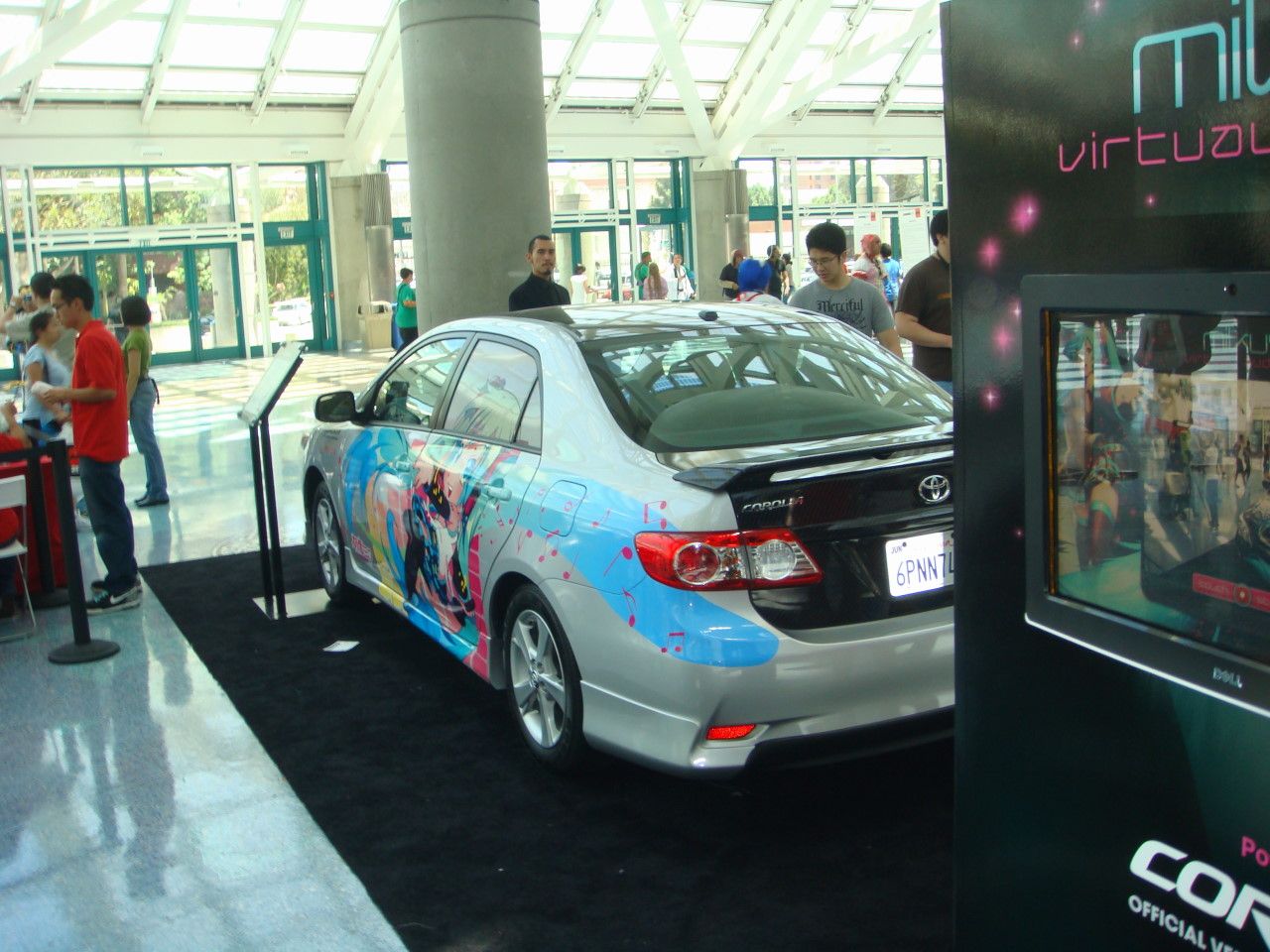
Of course, there was more to AX 2011 than virtual pop idols. I've never seen statistics, but I'd bet that AX 2011 has one of the highest concentration of costumed attendees (and of high-quality costumes) of any of North America's various anime, comic book, and science fiction conventions. This AX was no exception; the hallways were thronged with impressive costumes.

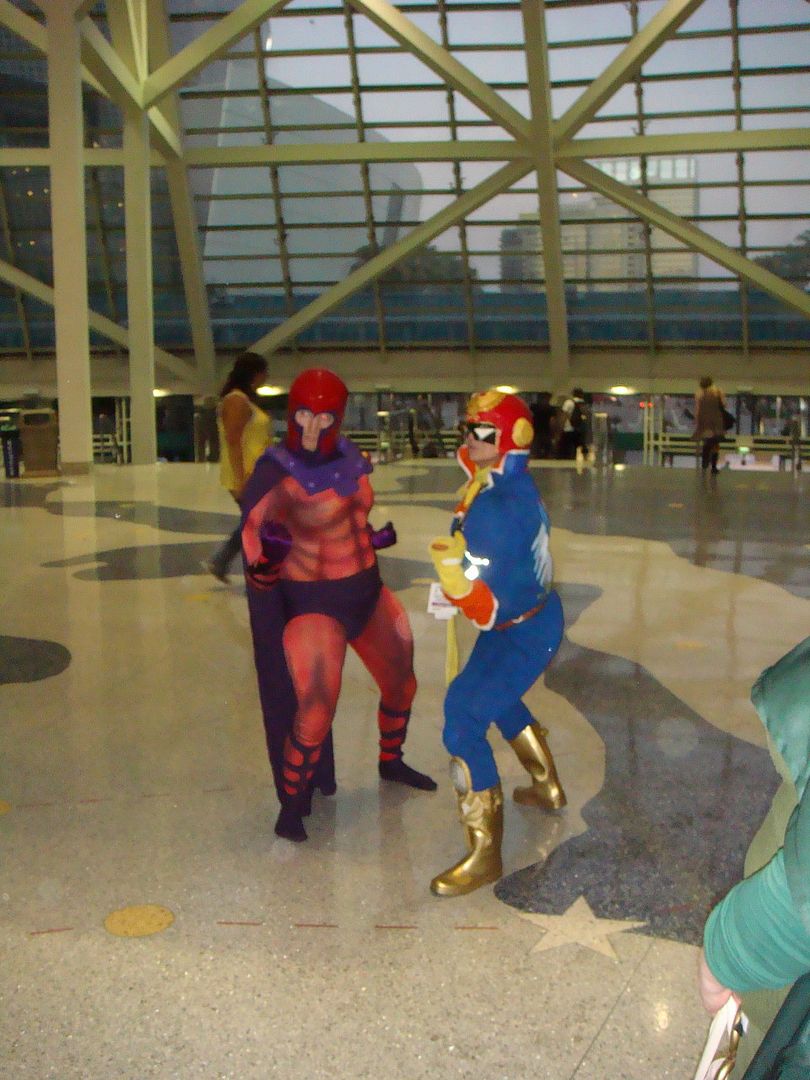
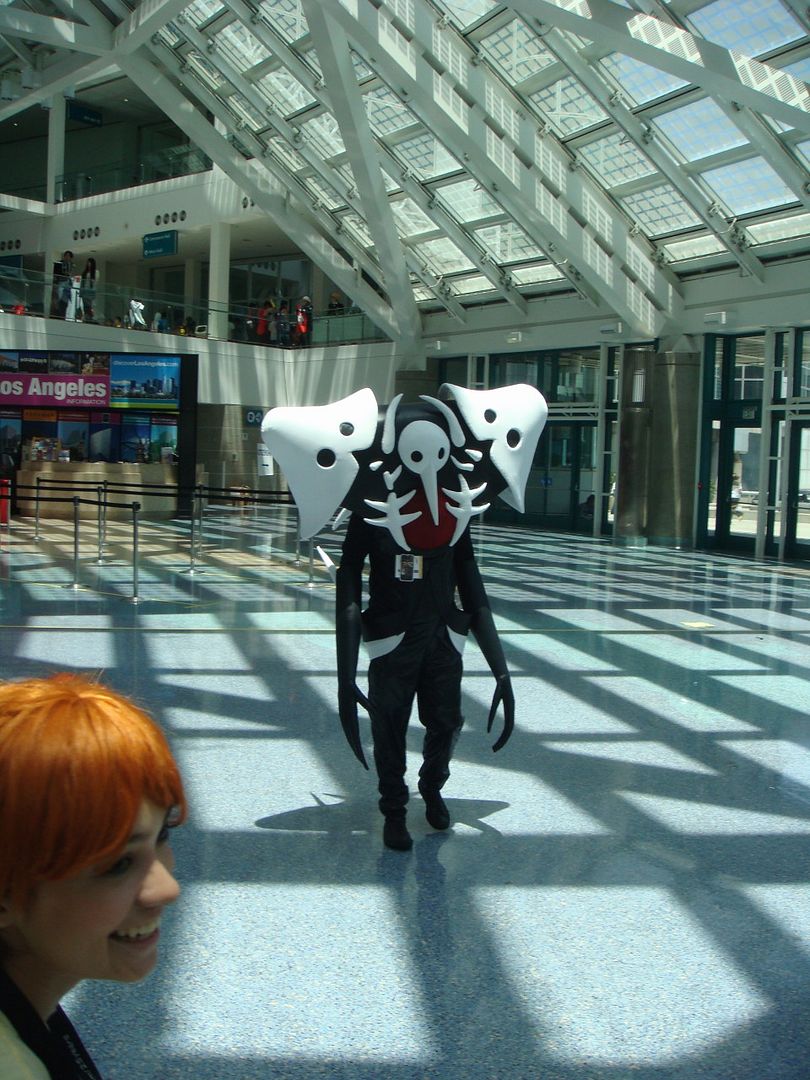
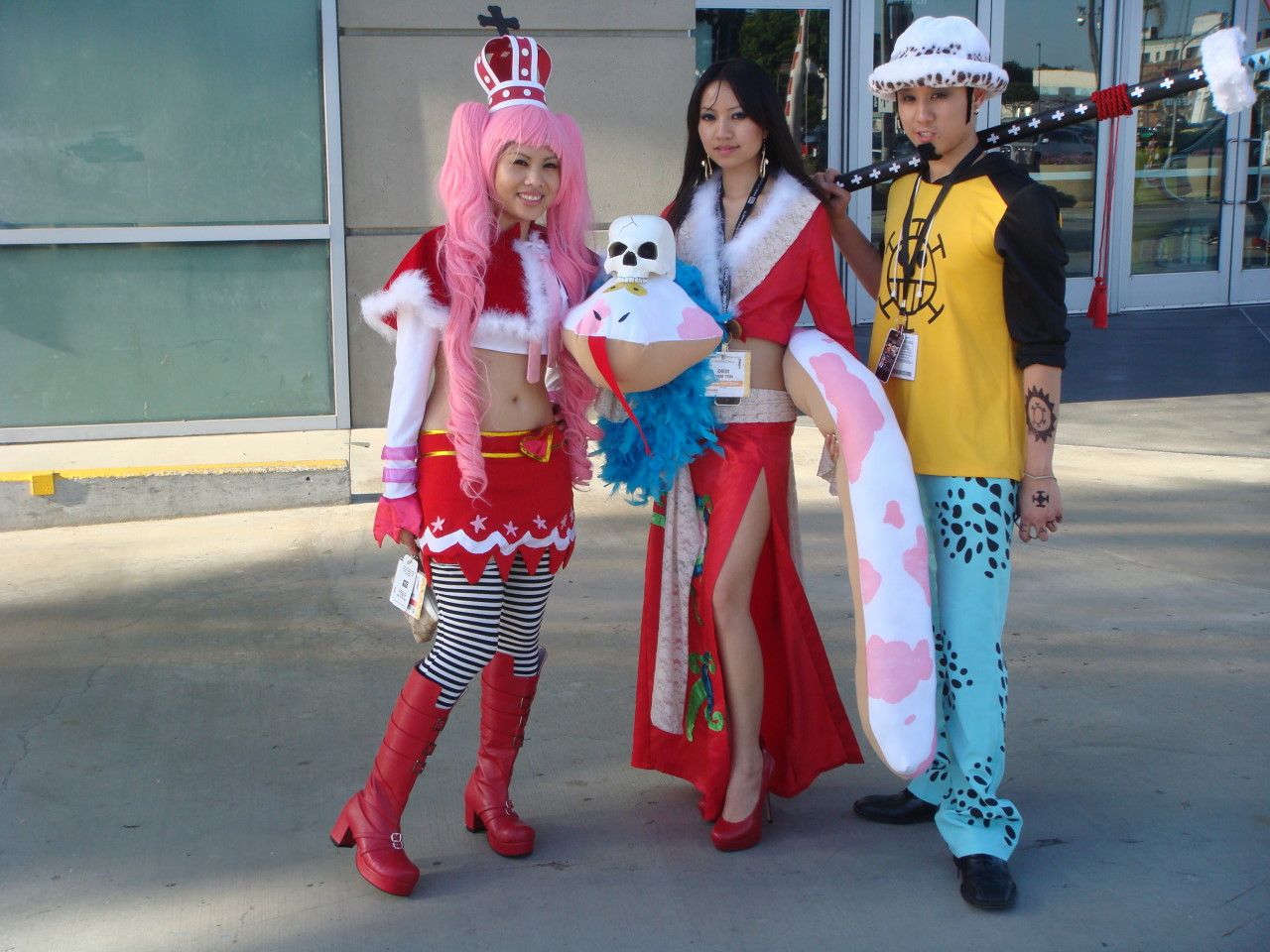
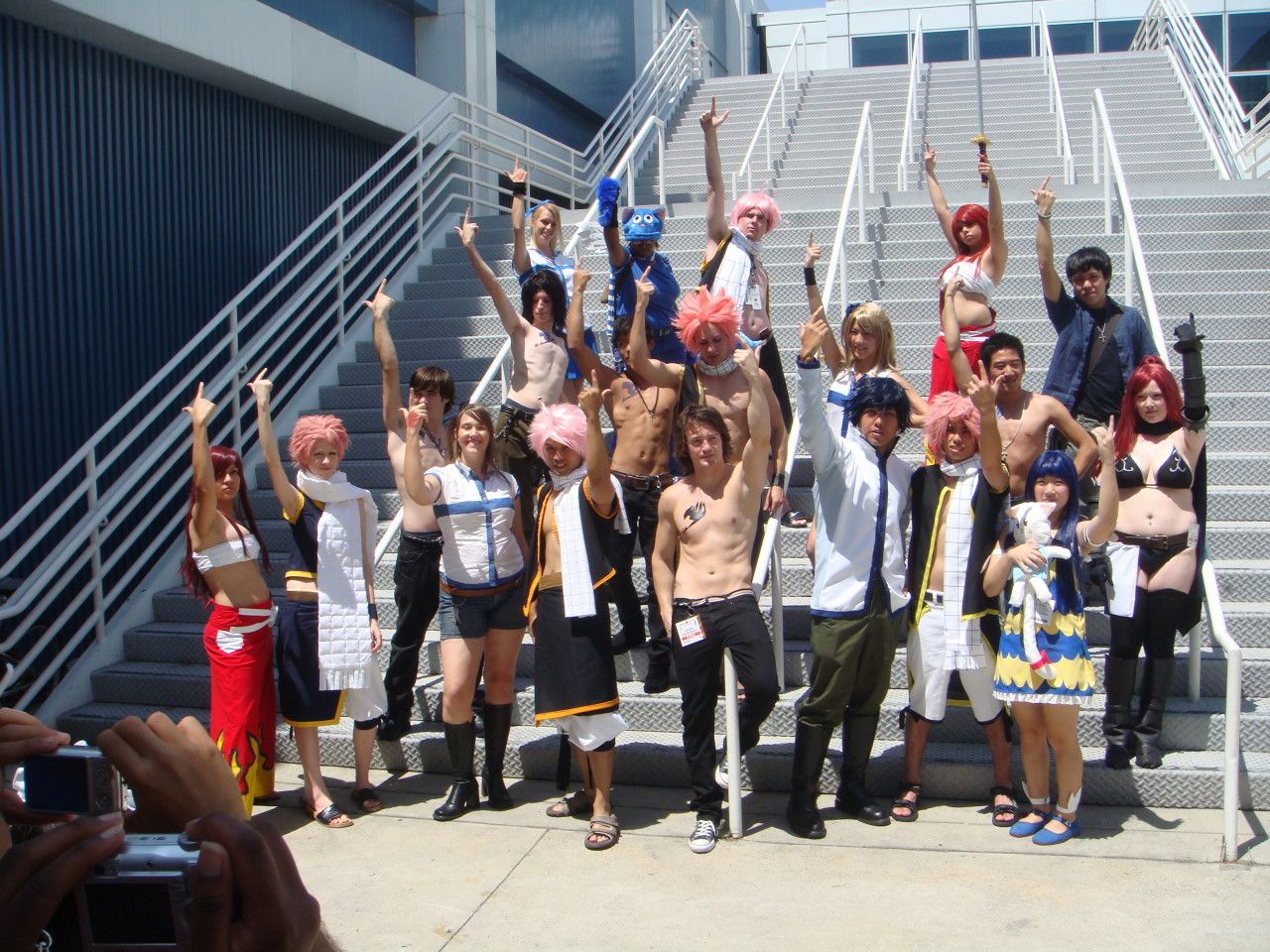
The attendance at AX was impressive, in light of the current U.S. licensed anime and manga industry. That industry has been in the doldrums in the last few years, as the bubble burst in the market for these products (due to, among other things, the crashing economy, the failure of the Musicland and Borders chains, and the lack of standout shows and manga titles). Indeed, for a couple of years, almost no new anime DVDs were produced. At present, only a few licensors are left out of what was once a crowded field; and only a few anime titles go through the expensive process of dubbing -- many are licensed only for the much less expensive Internet-streaming, subtitled market.
To make matters worse, licensing issues (including Japanese right-holding companies changing hands) have complicated the distribution of existing titles. In particular, although four translated editions of the HELLSING ULTIMATE DVD series have been released in the U.S., no new ones have come out here in the last two years (although the series has continued in Japan) due to contract issues. As a result, there were fewer cosplayers in Hellsing costumes this year; although previous AXs featured two or more Hellsing costume photoshoots, this one had none.
Also creating problems for the convention were a new anime con, AM2, which the founders (former AX staff) chose to put on during the same weekend as AX, and in the same venue where AX used to be held, in a possible attempt to hurt AX's attendance. (Didn't work, although folks we'd often see at AX spent the weekend at the other convention.)
Nevertheless, the attendance topped 47,000, which is huge by any standards; and the attendees had tremendous fun. Further, there were signs that a leaner anime licensing industry was pulling itself out of its sinkhole, with new licensing and dubbing projects. In particular, Bandai premiered a dubbed version of THE DISAPPEARANCE OF HARUHI SUZUMIYA, a feature-length coda to the two TV series adapting the light novels of a manic-depressive high school girl who unknowingly has the power to warp reality. (The two-hour, forty-minute feature is a tour de force for voice actor Crispin Freeman, who delivers dialogue or narration in every scene.)
And Funimation, which has emerged from the licensing miasma as the dominant company, held a raucous panel for its dub of the 2010 hit anime series DURARARA.
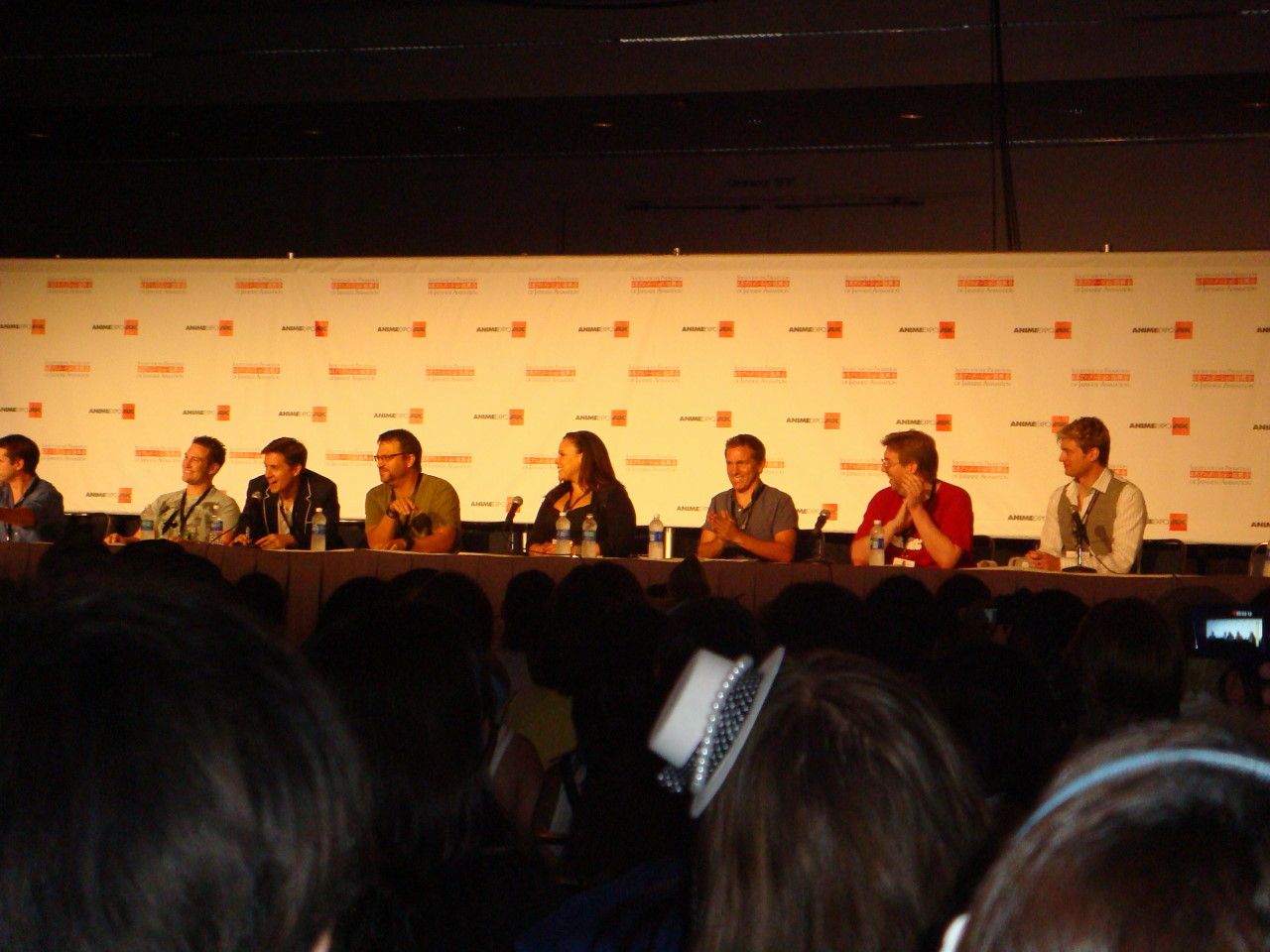
The success of the DURARARA DVDs is even more impressive because the entire series was made available to fans in 2010 (and is still available) for free, in subtitled form, on Crunchyroll.com. Yet the dubbed version has prospered, and is now showing on Adult Swim.
The events we attended included the Midnight Tea, in which fans created tea party settings based on anime and similar characters. The settings showed off the artistry and sense of fun typical of AX costumers.
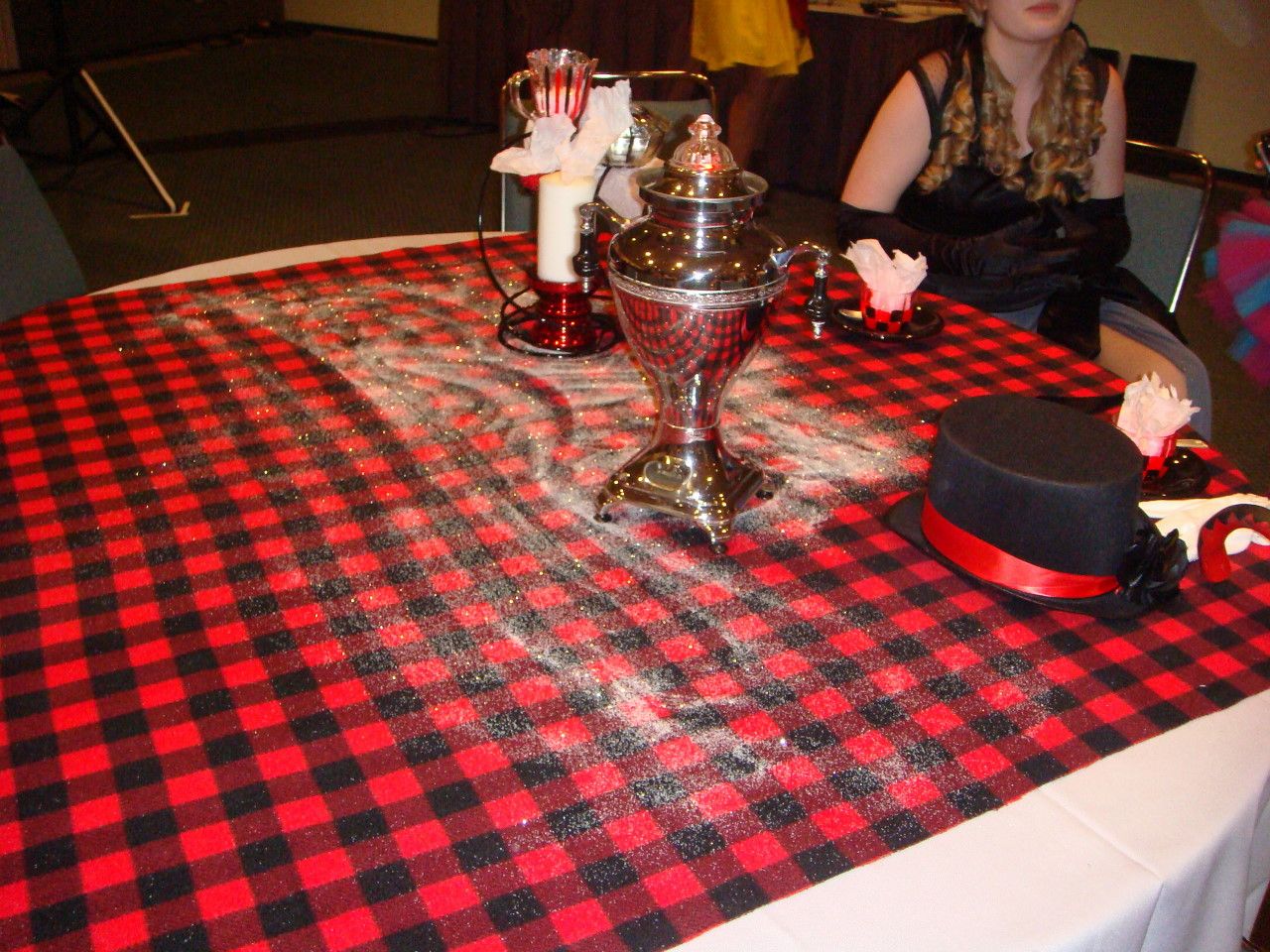

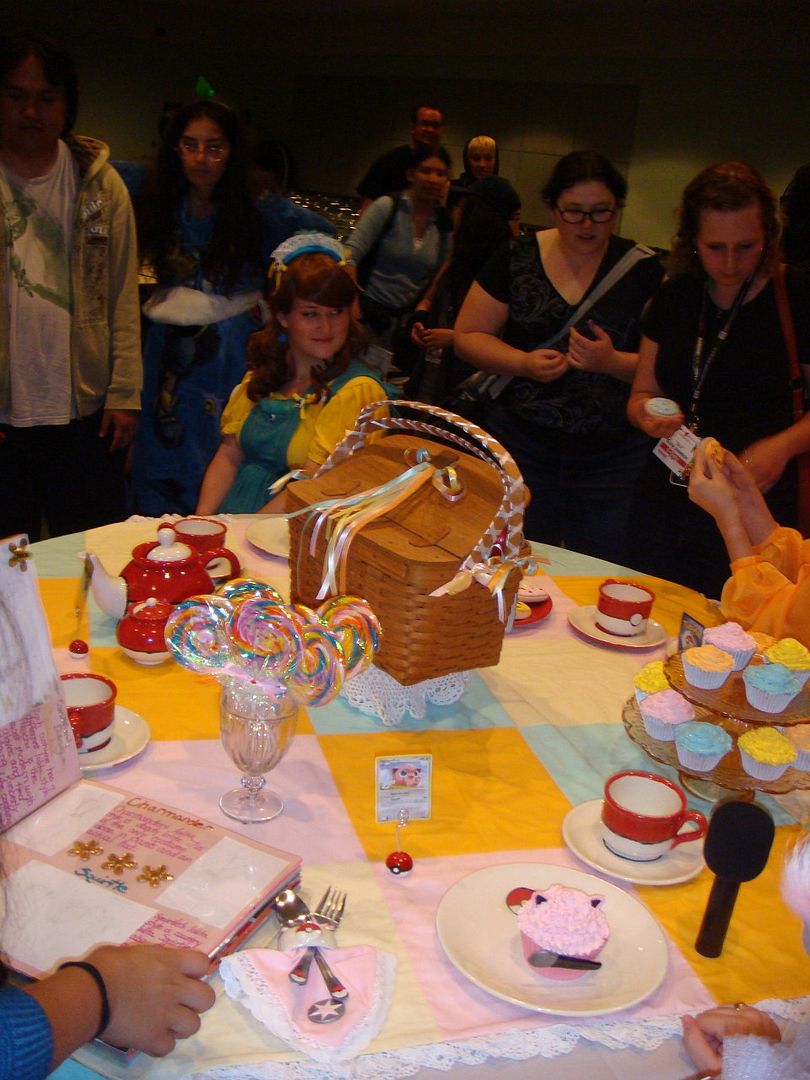
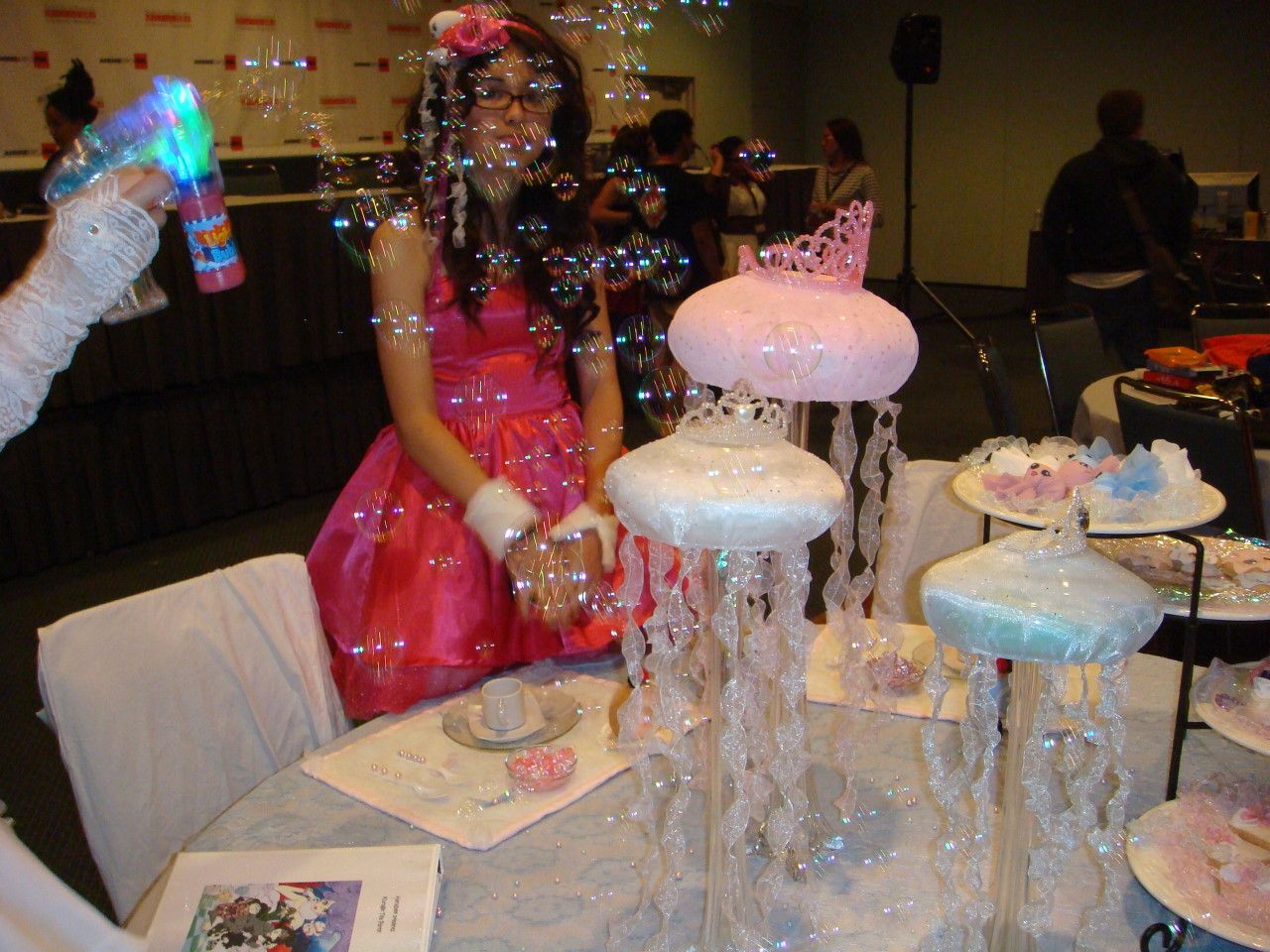
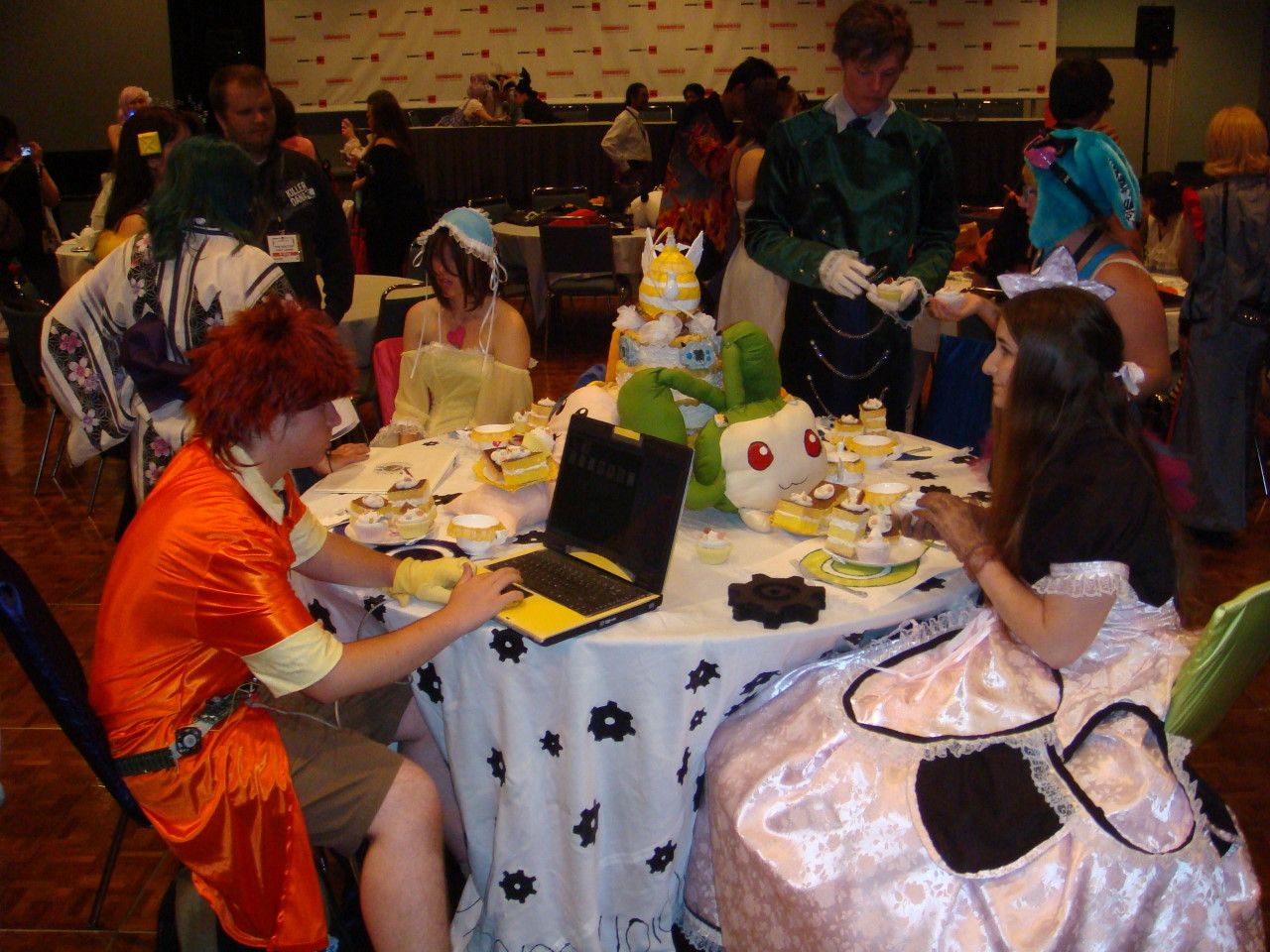
On Saturday, we attended the Hatsune Miku concert. The concert was the stuff of science fiction. The holographic singer, a huge glass screen behind her, was an amazing illusion: From a distance she looked like a human being, sharing a stage with the (excellent) live band backing her up; but a closer look revealed that she was indeed an anime character, with huge eyes, a tiny mouth, a bare hint of a nose, and an inhumanly streamlined body. Further, while she was occasionally raised and lowered onto the stage as if on a trapdoor lift, she was not limited to mimicking reality. Sometimes she changed costumes and hairstyles onstage, in the blink of an eye; sometimes she transformed into a ball of light, and shot around the stage, glowing stars in her wake, until she emerged in a different outfit. And while her voice seemed human (albeit autotuned, like so many current human singers), she would also sing some songs with inhuman speed and precision. Some of her fellow Vocaloid singers took their turns on the stage, sometimes in duet with Miku. The capacity crowd ate it up, dancing and waving glowsticks in time with their laser-light heroine.
http://www.laweekly.com/slideshow/anime-expo-at-night-hatsune-miku-in-concert-tune-in-tokyo-at-club-nokia-33682720/3/
For us, one of the highlights of every AX has been the Meet the Guests reception, at which the attendees (for a premium ticket) get to meet tha Japanese and American guests one-on-one. This one, however, may be our last. The price per ticket has skyrocketed (from $20 at our first one to $75 for this one); the time for the event was shortened (it was supposed to be held from 6 pm to 7:30, but folks were not allowed in until after 6:30); the venue was so loud that the Japanese guests complained; and while an impressive food spread was provided, the only liquid available was via a cash bar. Further, attendees were limited to five minutes with each guest before having to move on to the next. Despite these detriments, the guests themselves were delightful. Highlights included the folks behind the aforementioned Vocaloids; the production staff of LAST EXILE, the 2003 dieselpunk tv series that is being continued this year; voice actor Toshio Furukawa, whose career has stretched from MOBILE SUIT GUNDAM in the 1970s to his portrayal of Ace in the current hit series ONE PIECE; and ace American voice actor/director Taliesin Jaffe.
With all of its flaws, AX remains the place to see fantastic costumes, guests from Japan, and tens of thousands of enthusiastic fans.
Subscribe to:
Posts (Atom)